
Ashley Whitlock
Hampshire & IOW Butterflies and Moths

2023 Hampshire & IOW Nature Notes Blog









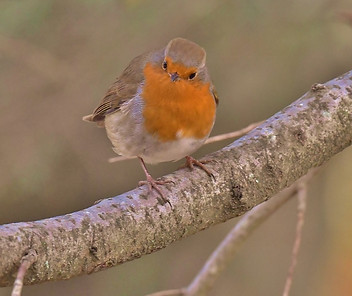
New Forest Bolderwood 29th /30th November 2023
A last look in and around the New Forest especially to look at the Deer Sanctuary, which was easy to find however no deer and I suspect they are present during the rut and also in the early part of the morning. There were a lot of birds to see especially birds I hadn’t seen in a long time like Treecreepers and Firecrests, with a lot of Robins in the mix. Toadstools were still in evidence and the trees were almost bare but with the odd smattering of golden leaf dotted about it made for some lovely ‘autumnal viewing’. I also looked for any evidence of sallow in the area I was in and there was very few sallow to be seen. So this part of the Forest would not be a good place to look in the summer for his majesty I suggest. Most sallow I have found have been very close to any streams or damp ground and I am compiling a list of areas of where to look in the future, and also having a separate page on this web-site on the New Forest in its entirety.

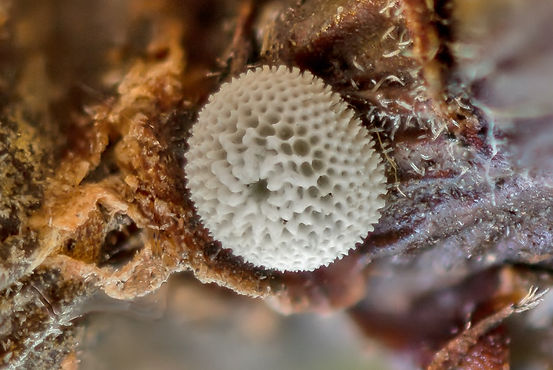
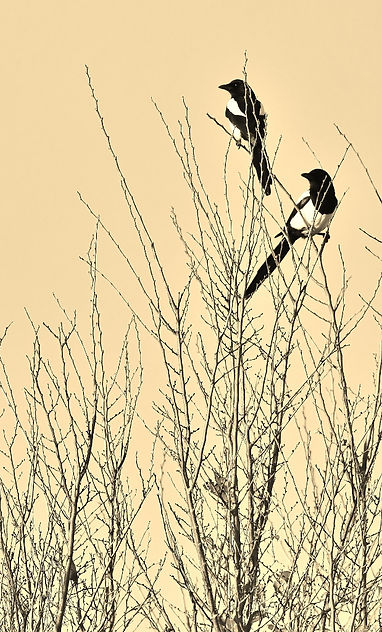
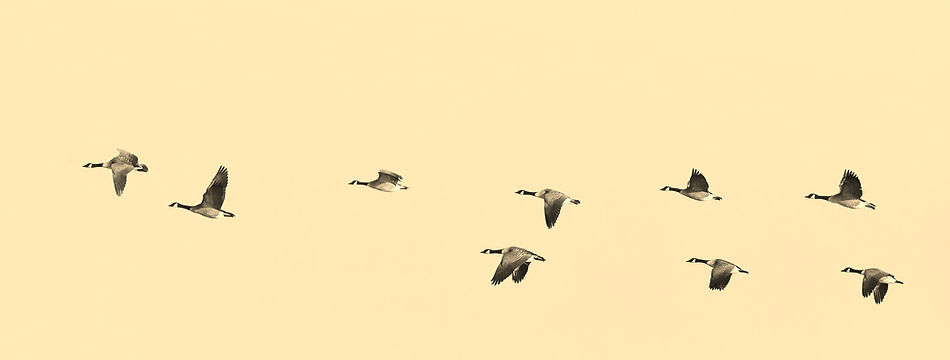
Milton Foreshore 28th November 2023
Another good day to get out and about and a look into the local wildlife patch and there were lots of Magpies up to 7 or 8 counted on a tree, it’s a long time since I’ve seen so many together. Redshanks and Brent Geese were feeding quite close to the shoreline. Walking around to the foreshore area, there wasn’t much to see as the tide had come in. Oystercatchers and Brent Geese were the main flyers, with Teal, Mallard, Black-Headed Gulls and Mute Swans were on the first lake and there didn’t seem to be any Kingfisher today. Rather disappointing really.
Out and about there has been Spoonbills seen at Keyhaven south of the New Forest, also one of the biggest surprises, a Sea Eagle passing over Titchfield Haven decided to alight for a while and a Bittern was also seen yesterday. In the middle of Winchester Salmon were seen going up river by the Mill in the River Itchen which must have been some sight, in the middle of the town. On the butterfly front Red Admirals Brimstones and Peacocks are still out and about in the sunshine, and a Purple Emperor caterpillar was found in Whiteley Pastures, and was found by the ‘dangleleaf’ method on a sallow tree.
.jpg)

.jpg)
Farlington Marshes Wednesday 15th November 2023
Another look for the Short Eared Owl at Farlington Marshes today, with the weather being good I was ever hopeful. The amount of rain we are still getting has made the grass very damp and sodden and this must hinder the Owls hunting, and it was suggested to me that the Owls haven’t been seen for a while in their usual place because of this and also disturbance by photographers and dog-walkers using a particular footpath which runs very close to where these owls usually hunt.
Now I am a dog lover, and the footpath is there to be used but you would think people would have more sense, and also photographers should keep away and stick to areas where they will not disturb them.
That’s it rant over….
The tide was out and there were good birds out in Eastney Lake like huge amounts of Sanderlings, Oystercatchers, Brent Geese, others I couldn’t Identify but there must have been Red and Green Shank Curlew. I also saw Avocets, and Lapwings, Stonechats, Wagtails. There was a large murmuration of starlings out in the estuary, amongst others. A single Common Tern was seen fishing, and over in the direction of Hayling Island Claire and I saw a Short Eared Owl being mobbed by a couple of black-headed gulls. Unfortunately he/she didn’t get too close to me so any photographs were minimal, but it was a great sight to see though.
Farlington Marshes / Langstone Harbour Thursday 23rd November 2023
Another visit to Farlington Marshes, the weather was against us in the morning, as it was quite overcast and it was distinctly cool. The Short eared Owl wasn’t showing either, and there was very little to see initially but as the day wore on the birds they were making themselves known and over the water there were good flocks of Oystercatchers Sandpipers, Knots and Turnstones, these seemed to feeding on the sea where the flats were not underwater. One of my favourite birds the Curlew was present and there were quite a few dotted around the site. Great Northern Divers were also seen by several of the wardens on Farlington Marshes.
Other birds of note were Stonechats, Goldfinches, Pied Wagtails, Egrets, Lapwings and Redshanks. In the afternoon there was a completely different weather as the sun was shining and was relatively warm. Other birds seen in Langstone Harbour were good counts of Coot, Mallard, Black Headed Gull, and Grey Heron. Around the county there has been a sighting of Red Legged Partridge in somebody’s garden, and Brimstone Butterflies were also seen on the wing as well. On the Hampshire /Sussex border more Brown Hairstreak areas have been found, by locating their eggs, which are quite easy to see now that the leaves have fallen off of the Blackthorn bushes.
Oh no he’s gone into bird mode!
In case anyone’s wondering why the sudden change to bird pictures there a distinct lack of butterflies and moths on the wing now, so with so many good bird watching opportunities like Milton Fore-shore and Farlington Marshes in and around me…and with the great opportunity to take pictures of Short-Eared Owls just around the corner, I consider myself a very lucky boy!
Anyway here are some waders taken today along the Milton foreshore when the tide was out Oystercatchers, Redshanks and Curlew, with Terns and Black Headed Gulls with Egrets in the mix. There were other waders like Turnstones, and Sanderlings but I couldn’t get close to them. The Red Admiral was still flying up and down the footpath close to the Falklands Memorial.
.jpg)
.jpg)

.jpg)
.jpg)
Garden and Eastney Beach 31st October 2023
A break in the continuing rainy weather with a day of sunshine which brought back the Red Admirals back on the buddleia bush. How they managed to survive the awful downpours of late is anybody’s guess. I decided to walk along Eastney Beach right to the end to see if the Little Owls were still there, unfortunately they weren’t. Whether they have left the area or not I don’t really know.
Walking along the beach I noticed a few Shorebirds and as I got closer there were a fair few Sanderlings, a couple Turnstones and the odd Oystercatcher to be seen. I was quite surprised to how close I could get to them, and as I walked further up the beach it turned out there were a lot of them , hard to say how many but a good hundred or more Sanderlings.
Garden and news of the Short-Eared Owls at Farlington Marshes
Almost through October now and it’s been a constant battle against the rain, with a huge area of low pressure stuck out to the west of us pulling in all the showers and torrential downpours every day, Except the one day a week where its bright enough to get out and look for Autumnal photographs. There has been some good reports of the rutting season is well underway, and many parts of the New Forest and other woodlands in Hampshire are echoing to the call of the male stags, as they round up their hinds and fight off any rivals that threaten their harems. In the garden there are still some very tatty Red Admirals to be seen, and the odd Painted Lady and over the past few days a nice fresh looking Comma.
Farlington Marshes welcomes back one of my favourite birds the Short-Eared Owl, where several have been seen quartering the reed beds for prey. Also the Bearded Tits are showing well as well, and won’t be long until multitudes of Brent Geese descend onto the Marshes, and swell in numbers into Eastney Lake.
.jpg)

Autumn
Shafts of morning sunlight cut through the canopy, scintillating motes of dust hang in the brilliant blades of still autumnal light and all is quiet for a golden moment before the distant belch of deer stags hacks through the silence. The deer rut, one of Britain’s great natural spectacles has begun, especially in the New Forest......
The rutting season, when stags face down and lock antlers with one another for the right to breed, starts in mid to late September and lasts until the end of October. As with all natural spectacles, it’s at its best at dawn and dusk and well away from people.
Needless to say, you shouldn’t approach any pair of large wild animals engaged in combat, but if you want to see deer rutting, you’ll probably have to lose yourself in some uncharted reach of the forest at crikey o’clock, wear muted clothes and be prepared to be quiet and patient.
The rest of us can derive the same sense of awe by just being in the presence of these magnificent beasts, and this short cycle trip in the New Forest is an easy way to spot our two most glorious species in a single afternoon. There’s even a cycle hire shop at the start of the route in Burley.


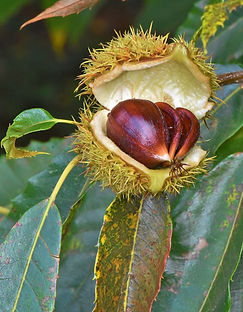.jpg)

.jpg)
.jpg)
.jpg)
.jpg)
Back Garden and West Wood Sunday 22nd October 2023
It’s amazing to think that the year is nearly complete and the butterflies are still going strong not that there are countless to see but in the back garden there was up to 8-10 Red Admiral flying in and around my Hebe plant which is still blooming quite well, whilst the Buddleia is fading fast, but with what is left of the sunshine in the north facing garden these butterflies are making the most of it. There was also a Comma having his fair share of nectar as well, and he looked in very good shape.
In West Wood I was looking for Fungi on the forest floor and was quite successful as you may well see from the pictures seeing Fly Agaric and Penny Buns, plus others which remain nameless so far. Even here the Red Admiral was still flying and also seen was Brimstone, several small whites and Speckled Wood.
.jpg)

.jpg)
Garden Butterflies 8th /9th October 2023
The garden Buddleia tree has been a haven for butterflies over the past few days. I have been plucking old leaves and buds off of it over the past few weeks to encourage new blooms, which have so far paid off. Yesterday in the late evening when the weather seemed to be totally perfect with nil wind and the warmth just seemed to be right. I looked over the tree and there were surprisingly at least 4-5 perfect Painted Ladies, which were probably home grown ones, and at least 8 or 9 Red Admirals, plus Large Whites, Small Whites, Hummingbird Hawk Moths and Hornet Bee Mimics (V. zonaria)
This morning it took awhile for the sun to get up to autumnal strength and once the Red Admirals started to alight the Buddleia the Painted Ladies joined in. One particular one liked our Palm Tree, and sat still looking down at me for quite a time, it did remind me of a certain Purple Species that does the same thing, unfortunately not in our garden! But it was a treat nevertheless.
Along the seafront was a single Common Blue and Small Copper
.jpg)
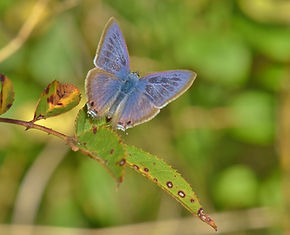.jpg)
.jpg)
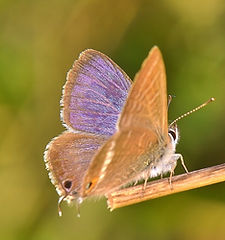.jpg)
.jpg)
Portsdown Hill Monday 9th October 2023
A glorious day was to be had on Portsdown Hill today as the sun beat down and next to no wind greeted us as the pursued one of the newest butterflies to be seen on the downland. The Long-Tailed Blue has been seen up on the down on and off over the last few years, and in 2023 it seems to have come of age, as many new foodplant sites have been identified. Fortunately we have had some good weather for it to breed into the late autumn, and today we saw the fruit of its labours. The site faces south and with several eyes all peering into the shrubbery we saw at least 7-8 individuals. Several were in very good condition which suggests these have just recently emerged. They were claiming territories, in a very similar fashion as the Duke of Burgundy, rising high up into the sky and intertwining on the way up, and then splitting and coming back down onto their perches. Several were quite worn, with very little of their tails to be seen.
We stopped in the area for a good hour seeing several mating and a third male trying to break up the party, he failed I hasten to add. The males in good condition posed quite nicely on the sun-drenched downland and seemed quite at home here, but it was a pinch yourself moment to really think these butterflies may well have become quite established here now. Other butterflies seen were another brood of Holly Blues, Brimstones, Meadow Browns, Peacock, Painted Ladies, and many Red Admirals, feeding off of the many Ivy bushes, and then flying down the hill.
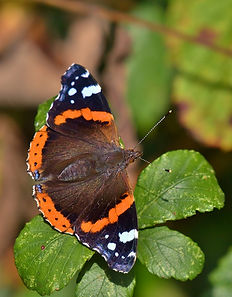.jpg)
.jpg)

.jpg)
.jpg)
Farlington Marshes Tuesday 3rd October 2023
Today was quite a cloudy day despite the weather forecast and very breezy and I walked around Farlington to see if I could see the Bearded Tits alas it wasn’t to be as the wind was very strong at times. The most noticeable thing today was seeing countless Red Admirals all heading south. This was quite a spectacle, as they seemed to zoom around me as if to say goodbye, for voting them the ‘butterfly of the year’. There were other butterflies still to be seen several Clouded Yellows were going in the opposite direction, and Small Copper and Speckled Wood was still on the wing.
Kingfishers were also out and about and there were lots of marshland birds to be seen like the Knot which were gathering with Redshank in numbers around the reed beds. Kestrels were out hunting so were families of Buzzards. Egrets and Curlews were fishing in the mudflats as the tide was out. Unfortunately I didn’t see my quarry the Bearded Tit as I think it was too windy. There were lots of Dragon flies still on the wing especially the Common Red Darter.
.jpg)
.jpg)
.jpg)
Eastney Beach Friday 29th September 2023
A break from the storms which are hitting the UK at the moment, although the South-East part of the UK has got off rather lightly so far. Along ‘my’ beach the butterflies have dwindled down to a handful, with no Common Blues or Painted Ladies seen today. The Clouded Yellows were patrolling up and down pausing every so often for a quick sup of nectar, where it could find some willing plant life. There were several female Small Coppers on the ‘bank’ one was the blue ‘spot ‘variant, which was good to see as it was different to a smarter one I saw later. A moth being a Rush Veneer noted to be a strong migrant was also seen. In the garden many Red Admirals are still feeding on the dwindling Buddleia, which won’t last much longer.


.jpg)
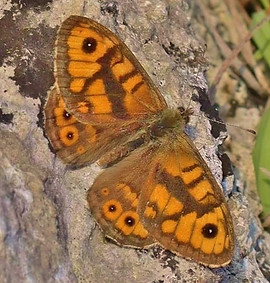

Eastney Beach Fort Cumberland 25th September 2023
It’s hard to admit that autumn just around the corner, and some of the trees are starting to show their yellow and rusty hues, and the bramble leaves are bathed in a red glow looking rather splendid. On the butterfly front it’s getting harder and harder to get a handful of species to count, the main ones seen on Eastney Beach and just around the corner at Fort Cumberland are, Speckled Wood, Common Blue, and the Clouded Yellow sometimes but not every day, the odd Small Copper, many Small Whites and the odd Large White, and on the beach the Painted Lady with Red Admirals still turning up in the garden. I know on the Isle of Wight and several downland sites on the mainland the Brown Argus and the Wall Brown are still being seen with the odd Small Heath, and even the odd Brown Hairstreak at Soberton, these being noted as ‘pristine’ which makes them extremely late emerging.
Birds seen over the last few days have been the White Tailed Sea Eagle patrolling the Solent, obviously one of the ‘introduced specimens from the Isle of Wight. Also the Bearded Tits are starting to show at Farlington Marshes as well, and it won’t be long before the Short Eared Owls are reported. On the mud flats many Sanderlings and Knots have been gathering, and good forms of Starlings along the Milton Shoreline, which should soon form a ‘mini’ murmuration.
.jpg)
.jpg)
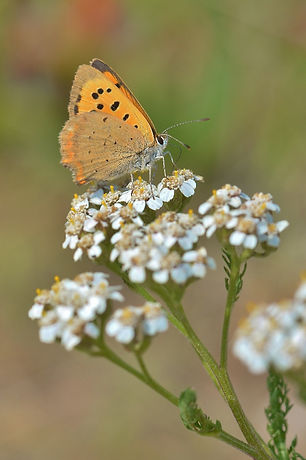.jpg)


Eastney Beach Friday 15th September 2023
Excellent hot weather on Eastney Beach and today and there wasn’t a cloud in the sky when I visited Eastney Beach. Today there was a lot of Kite Surfers as there is a International competition along the beach at Eastney. I had to walk a fair distance to find my quarry and sure enough there was at least 4 Clouded Yellows to be seen. Unfortunately they did not stop as the weather was very warm so they made the most of it! Other butterflies seen were several Small Coppers, Common Blues which seemed to have had another brood, and a first for me on this site was a pristine Brown Argus. I think this site has more broods than other sites as it perhaps has more sunshine.
The Common Blue and the Brown Argus must lay on other plants as I’ve looked for their host plants and there isn’t any. Other species of interest is the Bee Wolf which I find fascinating; they are constantly on the hunt and being sandy the slopes are littered with holes where the prey is kept.
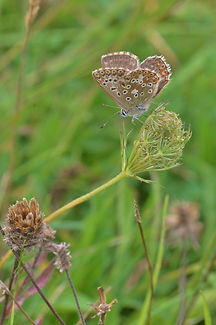.jpg)
.jpg)
.jpg)
Old Winchester Hill Friday 8th September 2023
The heat was just so exhausting and even on the summit there wasn’t any sunshine at the time just a thin veil of cloud, which kept the heat in like a vacuum. It was good for the butterflies as they were enjoying the last days of the season, and most importantly the Silver Spotted Skipper was in good numbers. I walked over to the far slope facing south, and looked on both sides of the footpath, where the sheep had been grazing the sward was about 5-10mm in height and here there wasn’t any Silver Spotted Skippers of note, and very little wild flowers. On the opposite side the sward height was between 20-30mm in height and this is where I saw the majority of the Silver Spotted Skippers.
The rabbit burrows all seemed to be on this side as well. Next year the side where the sward is the shortest should yield some good results for the Silver Spotted Skipper and the Adonis Blue as well. I counted up to (40) individuals and there were still plenty of very fresh specimens only a day old I would say. There were good numbers of Adonis Blue still but dwindling numbers of Chalkhill Blue, fresh Small Copper and Brown Argus were also noted. There were no Clouded Yellows noted. On the summit I was witness to a large flock of House Martins and these for some reason had an interest in the local Kestrels, they were certainly mobbing them, maybe they though the Kestrel was a threat to eating their insect food.
Old Winchester Hill Tuesday 5th September 2023
Another visit to Old Winchester Hill to see the fading species like Silver Spotted Skippers, and Adonis Blues with the heat they are fading quite fast. The Adonis Blue seems to have done rather well here in 2023, but the Silver Spotted Skipper was rather hard to find so early in September. Usually that’s when I get my best counts but today sadly it was just (7). The butterfly which has made a big impact in numbers is the Small Heath, one of those butterflies that we barely give a nod to, just because we always know they are there. I find it a lovely little butterfly and deserves more rankings than it gets. Two Clouded Yellows passed me, when I had settled down for a rest, these being the first of the year, and they were not stopping only briefly for a quick drink on a thistle, or Scabious.
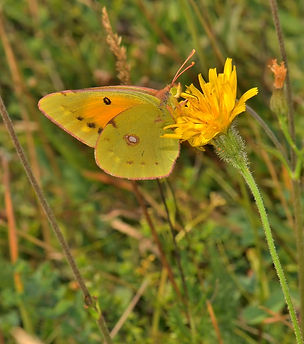

.jpg)
.jpg)
%20(1024x692).jpg)
%20(1024x658).jpg)
.jpg)
Old Winchester Hill Field Trip Sunday 3rd September 2023
It doesn’t get much hotter than this as we walked around Old Winchester Hill today without a coat in case it rained. In fact in the afternoon it was really too hot to do that much. We saw all but one of our target species, the Clouded Yellow will probably appear at the end of the week as there is some warm southerlies coming in, so hopefully they should appear then. There were some good numbers of butterflies today. The top prize I think went to the Small Heath, they were everywhere. A close second was the Meadow Brown. Also there was good numbers of Adonis Blues, mainly males and most of these were in good condition, and Silver Spotted Skippers were buzzing about mainly females, and several were seen laying eggs, along with a couple of female Adonis Blues on the short turf on the far southern slope. Several Painted Ladies were seen as well, but you do that feeling that despite the warm weather the ringing in of autumn is very close by.
.jpg)
.jpg)
Beacon Hill Field Trip Wednesday 30th August 2023
Another cloudy day with the threat of rainfall as we wandered around close to an area where there were sheep and goats keeping the sward short and sure enough there was a couple of Silver Spotted Skippers to be seen. There were small amounts of other species the best were Brown Argus and Chalkhill Blues, mixed with a few Common Blue. No Adonis Blues were seen along with the very illusive Clouded Yellow. We saw several moths Common Carpet, The Snout, Hebrew Character, Silver-‘Y’ and several micro moths as well. But we drew stumps again quite early as the weather was cool and cloudy and made searching for butterflies very hard.
.jpg)
.jpg)
Butser Hill Field Trip Sunday 27th August 2023
The ever increasing threat of rainfall as we all walked down to the bottom of Butser Hill was forever on our minds although we did see the sun, the wind was getting up and it was decidedly cool. The species count was quite low consequently but we did pick up two of our three target species. The Adonis Blue seems quite settled here now and there was at least twenty or more individuals seen, although I only saw males. We had to search high and low (literally) along very steep slopes to try and pin down a Silver Spotted Skipper. We did manage it with a lot of perseverance, and many of the group hadn’t seen one before, and it was really worth all the effort. We saw about three or four but I think this site is quite late, due to the fact the southern slope takes a while to see the sun. However after lunch we drew stumps as on the horizon the sky was black and we hot footed it back to the carpark.
%20(683x1024).jpg)
.jpg)
.jpg)
Noar Hill Thursday 24th August 2023
A complete contrast in the weather today complete cloud cover, with the ever threat of rain…and boy did it rain. But not before we had seen a beautiful Female Brown Hairstreak sat on a leaf of Hemp Agrimony just waiting for the sun to appear, just so lucky to be looking in the right place at the right time as she took off as we approached never to be seen again. Also seen were Common Blues and Brown Argus in-between the showers. Never be put off by the threat of rain! Obviously it was too cloudy and cool to see any flying from any males over the Lecking trees, but the amount of butterflies and moths were a treat despite the weather, and we went home happy.
.jpg)
.jpg)
.jpg)
Portsdown Hill Field Trip Wednesday 23rd August 2023
A decent day with sunshine all the way and it was very warm for walking so we didn’t go too far and made our way to an area where I have always thought in the past that this would be a suitable area for the Adonis Blue. Over the last couple of seasons the species has been seen, but is it breeding? There is obviously their foodplant there as there is a lot of Chalkhill Blues to be seen. Also the species has turned up in reasonable numbers at other sites in the Meon Valley as well, so it could well be spreading by natural means. It took a few minutes to tune into the area where there was a lot of other blues Chalkhill Blues were very common and Common Blues were flying there as well. Then Bingo, a male Adonis Blue was spotted and he was in fine condition, probably a day or two old.
So that was one target species seen, along with several Autumn Ladies tresses, a very delicate Orchid seen on the short turf. We also saw a lovely Great Green Bush Cricket which posed rather nicely, and in the afternoon we espied several eggs laid by female Brown Hairstreak, but alas there wasn’t any luck seeing the female flying about or laying her eggs in the great swathes of Blackthorn on the northern slopes of Portsdown Hill, however several males were seen flying around a lecking tree close to the Churchillian carpark.
.jpg)
.jpg)
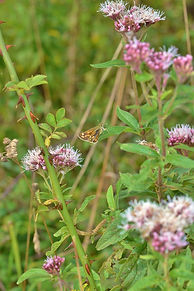.jpg)
Meon Valley Tuesday 22nd August 2023
Cloudy and overcast as I approached this site and all of the species were laid out flat wings open and photography it was like shooting ducks at a fair. I won’t ever hesitate to come out again in a dull and dreary day…as long as it’s warm. However the sun did come out eventually and was really warm and this sparked a flying frenzy especially the Silver Spotted Skipper, which is always a joy to see. The Adonis blue seems to be really established now with several females seen as well, and many males in various stages of disrepair probably been out several days here. Still no Clouded Yellow and the Dark Green Fritillary seem to have finished. Along the side of the site where the woodland parts are I espied a Valezina Silver Washed Fritillary looking very warn. Several moths were seen the Common Carpet lived up to its name and I also saw a Green Carpet, along with Mint Moths.
%20(2).jpg)
.jpg)
.jpg)
.jpg)
Portsdown Hill Monday 21st August 2023
Second helping of visiting Portsdown Hill with Mark Tutton gleaning more information on where are the best areas are to look for the illusive Brown Hairstreak, and they are mostly in areas where I have long suspected where they would be over the years. We thought we saw a male over the top of an Ash Tree in one of the hedgerows on the border of Fort Widley, and the behaviour was certainly how I saw them at Noar Hill last week. But alas the weather, being mostly thick cloud, with very little sun to speak of, just about put paid to any possibility of seeing a female, going about her business.
We did find some eggs so they have been busy with egg-laying over the past few weeks. I did come across a yellow colouration Jersey Tiger Moth f. Lutescens which I don’t think I’ve ever seen before. Last week we saw over 21 species today we barely made 10 what a difference a week makes!
.jpg)
.jpg)
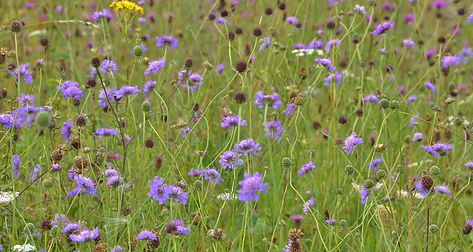%20(2).jpg)

Noar Hill Field Trip 16th August 2023
Very warm weather greeted us at a site which is full of wild flowers you don’t know where to look and looking for the elusive Brown Hairstreak is not an easy task. I had mentioned one of the ‘lecking trees’ in my brief and low and behold we got there and there was several Male Brown Hairstreaks having a chase and a battle intermingling with several Purple Hairstreaks as well. The Brown Hairstreaks were on an Oak so it was hardly surprising that they were being chased off as trespassers!
Close by there was an area full of Hemp Agrimony and from past experience there is normally a male or female imbibing on this and sure enough there was a male having a good old feast. Unfortunately we didn’t see a female Brown Hairstreak as this site tends to be quite late compared with Shipton Bellinger. There were lots of other invertebrates flying around, good numbers of Common Blue with small numbers of Brown Argus, and Small Copper. We also saw one of the last Small Blues in one of the pits. Many thanks to everyone for an excellent field Trip.
.jpg)
.jpg)
.jpg)
.jpg)
.jpg)
Portsdown Hill Tuesday 15th August 2023
Visited this site with Mark Tutton, on a very warm day, more like summer and he and I were searching for the illusive Brown Hairstreak. Over the last decade or so the species has had a tentative foothold on the area. The area is covered in Blackthorn thickets, in fact every hedgerow is Blackthorn, and there are suckers always growing in the meadows which are to their liking to lay their eggs on. We had been searching for about 30 minutes when something caught my eye and there she was a beautiful female Brown Hairstreak just landed in front of us typically well above our heads, but close enough to see the patterning on her wings. She stayed with us for a couple of minutes and then she flew off I suspect to start egg laying, although I lost sight of her.
We only saw the one in a couple of hours of searching. We also had good views of Oak Eggar Moths which fly around like crazy, being very hard to follow. Also a male Dark Green Fritillary made a pass as well which was a surprise. Other species of note were Chalkhill Blue, Small Copper, Brown Argus, formidable counts of Holly Blue, as Mark said’ one seen at every footfall!’ Also several lovely Jersey Tiger Moths were observed as well which seem to be having a bumper year as well as the Holly Blue , and Red Admiral.
.jpg)
.jpg)
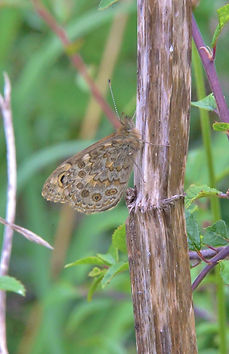.jpg)
Shipton Bellinger Field Trip Sunday 13th August 2023
When I looked out of my bedroom window this morning it had been raining and my initial thoughts were of a cool, wet windy and cloudy day with very little to see. That couldn’t have been further from the truth. An excellent turnout greeted me, and before we really got underway we had rescued an Oak Egger Moth which was trapped in the Village Hall, and I put it amongst some shrubbery as we set off. Even with the threat of rain on the horizon the sun did poke it head out on several occasions, which gave us glimpses of battling male Brown Hairstreaks in the main ride, these could be observed at close quarters, and several landed on a leaf and I could see they were looking quite battle scarred!
Several worn and fresh looking Wall Browns were also observed in the morning’s walk, along with Brown Argus, and Common Blue with Holly Blues skipping through the large areas of Ivy clinging from the tall shrubbery of Blackthorn. The Red Admiral was noted as being a lot scarcer today, being the butterfly of the year I suspect. Wall Browns became quite common dare I say it skipping along the hedgerows, and they did stop on several occasions to feed, but it was very brief. In the afternoon the sun did appear again on occasions, and we all had good observations of fresh Female Brown Hairstreaks well down on the ride and these were tasting the Blackthorn leaves with their feet and rubbing their abdomens up and down the stems of the blackthorn. In the end we counted up to 25 males and females which is a very good tally. Sadly for the second year running no Magpie Moths were observed, which is quite concerning, although we did see several Jersey Tiger Moths.
I’d like to thank all who came and made this a most enjoyable field trip.
.jpg)
.jpg)
Shipton Plantation Friday 28th July 2023
Although opposite to Shipton Bellinger the terrain at this site is different to Shipton Bellinger as it has more meadows and grassy verges along the tank tracks, and the deep cuts through the chalk look like miniature cliff faces which are just what the Wall Brown Butterfly likes. We saw up to three individuals flying up and down, however as the species become more numerous than they should spread out ideally suited to the meadows, which are full of Birds Foot Trefoil and Sincfoils. The Brown Argus is very numerous here as is the Small Skipper. However we never saw the Brown Hairstreak, looking at the area where I espied one female last year, there is plenty of Blackthorn here, and they are reported here quite often over the last few years.
There are plenty of Ash trees and Sallow and I suspect the Purple Emperor is around this site although I’ve never had any records of it, and there is plenty of scope for a an Assembly Point looking up from the car-park.
.jpg)
.jpg)
.jpg)
.jpg)
.jpg)
.jpg)
Let's hear it for the Chalkhill Blue.......
.jpg)
.jpg)
.jpg)
West Harting Down Field Trip Sunday 16th July 2023
Still blowing a gale In the tree tops as we set off with cloud cover covering three quarters of the sky but we were all in high spirits hoping for the best weather wise as long as it didn’t rain! Along the very long ride at the bottom of the site there are numerous spots where I’ve seen HIM but today wasn’t one of them despite looking skyward for most of the time. However the ride was full of invertebrates and one of the highlights was Dark Green Fritillaries, Small Copper and several White Admirals and Silver-Washed Fritillary.
The large areas of Sallow kept me on my toes hoping for a glimpse of the Lady Emperor, and we saw a very quick glimpse on a tract on a footpath going through many sallow stands, probably where a female was just getting ready to lay eggs at about 11:30. This led onto another good ride where the sallow was just everywhere and I’ve encountered good sightings of the ‘Empress’ and soon enough we encountered a female Emperor overfly some of us giving a good view of her underskirt, and then she disappeared into a sallow thicket. Almost immediately there was another a bit further down the ride but she scuttled off into a Hazel stand.
On to the summit the ‘butterfly of the year’ has to be the Red Admiral as they were absolutely everywhere.. As we ate our lunch I went for a wander and there were 7-8 feasting on something not very nice, and the buddleias were festooned with all the Vanessids, and Hummingbird Hawk Moths put in an appearance as well. Coming back I managed to save a pair of Commas in the road from being squashed as they were busy mating, and I would like to thank everyone who came for a very enjoyable trip even if it was the top end of 7 miles!

.jpg)
West Walk Wednesday 12th July 2023
This woodland is growing on me as time marches on with the Purple Emperor season in its final week or so, in Hampshire, and today with a very windy day and mostly cloudy I didn’t expect really much. I set off down the main ride from the car-park and had noticed before how much sallow there was in the ride and very tall mature oak trees. The Forest of Bere is ancient woodland going back hundreds of years, and it has many parts dotted over the southern part of Hampshire. I had seen a Purple Hairstreak descend down onto the ferns close-by and I managed to get photos of him, and there were several Red Admirals flying about, but no Silver-Washed Fritillaries and only one White Admiral observed. Halfway down the ride at 11:45 I saw a large male Purple Emperor sallow searching weaving in and out of a sallow not more than 20 feet above my head, he was seen for a few brief moments, but long enough to see he was in good condition. At 12:00 another male was seen a bit further down the ride, and the one we had seen previous was seen as well so we knew we had at least two Emperors sallow searching, in the breezy and cool cloudy conditions. These brief moments were our limit as the weather was getting worse and the spots of rain started and the wind was really lashing the tops of the trees so any observations now were going to be very limited. So we went back to the car-park for coffee and cake. (Mimi makes Bakes and cakes thoroughly recommended!)
.jpg)


Micheldever Wood Field Trip Sunday 09th July 2023
It was raining in the car park as we all gathered and were wondering what the rest of the day held….although it wasn’t long before patches of blue sky appeared and we set off in to pastures new for our quarry the Purple Emperor. There were lots of Coniferous woodland on either side of the main ride, and very little sallow, and then we had good stands of mature Oak interspersed with sallow further along the ride. There were good areas of Blackberry bushes where there were good counts of White Admiral and Silver Washed Fritillary. The Red Admiral count went through the roof, and we had to be careful in the ride not to step on them. There were several newly hatched Painted Ladies. In the last week or so there have been excellent counts of Purple Hairstreak, but today we really did struggle to find it. HIM never materialised in the morning, probably not warm enough.
In the afternoon we went to the Assembly point and as we arrived on the side of a very mature Beech tree I espied two male Purple Emperors having a good fight tumbling down and then splitting, this was at 13:45, by this time the sun was shining again after having a cloudier spell making it a lot warmer. We then got a low pass by a male swooping down just over our heads heading west at speed, at 14:00. We all gathered in the Assembly area but there wasn’t any action, just two males seen just flying over the tops of the oak and Ash tree. I suspect we missed a lot of the action when we were in the car-park having lunch when the sun was shining and it was a lot warmer.
%20(1024x673).jpg)
.jpg)

Abbotts Wood Inclosure Friday 7th July 2023
Visited Alice Holt Forest on one of the hottest days of the year, and throughout the day looking up at the mighty Oaks today it became apparent that there were a lot of Purple Hairstreaks. Many were coming down to head height and feeding on the honeydew, and then alighting on the ferns and then feeding on Bramble. The other highlight today was seeing so many Silver-Washed Fritillaries, I haven’t seen so many I don’t think for many years. A magic moment along the main ride when I espied a lovely ‘Valezina’ and it was in perfect condition, she was so perfect I was struck by its beauty, just by the light shining through the foliage of the Oaks dappled her silvery grey colours, as she flitted from bramble to bramble and occasionally warding off potential suitors.
On the Emperor front I was in the wood early, but there was very little sign of HIM, until 10:20 when the first male was seen, and then it was just a few low passes as they were sallow searching and oak edging, one of the best passes was a large male in good condition passing right over the ride to follow the sallow line right to the back of the ride, this was on the time of 11:00, which signals the rush, although today it was just a dawdle around the ride for several of the males. I saw up to 9 Emperors, but this probably equates to about ¾ as there was probably more than one pass by several of the males.
The heat must have affected them as I visited 4 Assembly points in the afternoon and these were either empty or they were just too fagged out to bother squabbling over territories.
.jpg)
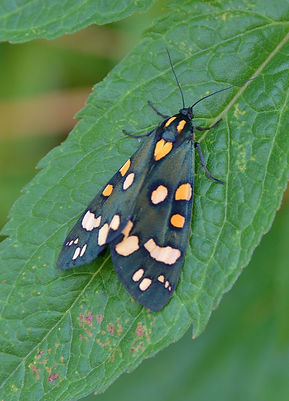.jpg)
West Wood Field Trip Wednesday 5th July 2023
Another day of cool cloudy conditions, and there wasn’t much hope of seeing much at 07:00 in the car park of West Wood, however by the time the field trip started the blue sky had appeared but so had the windier conditions, but we were extremely lucky to get away without a shower! The Emperors now are reluctant to fly and when they do it for very short periods and with this in mind we scanned the tops of the trees for several hours falling short of anything resembling a Purple Emperor .On the magic hour of 11:00 the Emperors had suddenly got out of bed and we saw several, but just glimpses of them Oak edging and flying across the main ride. What we did see a few of were Scarlet Tiger Moths, several were roosting in the tall grasses but several others were flying down the main ride. There were Silver Washed Fritillaries mating and a couple of White Admirals, but on Pitt Down this year the Dark Green Fritillary was barely noticeable, only a couple being seen in the taller grasses where the Knapweed flowers.
I’d like to thank all who came especially the new faces and look forward to seeing you on the next field trip.
.jpg)
.jpg)
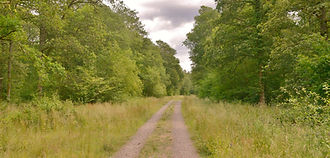
Straits Inclosure Monday 3rd July 2023
Following on from Abbotts Wood Enclosure, the following day I visited Straits Enclosure, where today it was really gloomy and breezy in the canopy. However there were several intervals of sunshine and after counting good numbers of Silver-washed Fritillary and White Admiral we saw at the magical time just after 11:00 a vista of up to 4 male Purple Emperors having little bundles over the oaks and then parting their ways to Oak edge and sallow search. As we waited for the next instalment of flying I noticed a strange looking White Admiral sitting on a Hazel leaf. After looking at it through my long lens, which I will be grateful for, it turned out to be an ab: Obliterae, of which Straits Enclosure is quite famous for.
There were several more instances where males were searching the tops of the oaks coming from the west and ones coming from the east and they would tend to bump into each other and have a little fight and then go on their merry way. Today I counted up to twenty males just ambling about and searching for that elusive female.
.jpg)

Alice Holt Forest Field Trip 2nd July 2023
A good turnout at Hampshire’s most prestigious Purple Emperor site, made it for an early start at 0930, and once in the ride the cloudy conditions were hampering any real sightings of our quarry. I first blew my whistle at 0950, with a male Emperor flying fast over the main ride. We walked along the main ride stopping at major points having a look at all of the flora and fauna, with plenty of Silver-Washed Fritillary including two aberration’s ocellatta and valezina, While White Admirals were tormenting those who were convinced what they were seeing were Purple Emperors, however these were certainly not confusing when several sightings came along with one male coming down halfway of a small Oak and clearly displaying all his regal Purple.
I espied many Purple Emperors Oak edging and sallow searching throughout the cloudy conditions but with sunny intervals with a stiff breeze at times. In the morning I counted up to (30) males and we made our way back to camp very happy about 12:50.
in the afternoon a few of us went back down into the woods and the breeze was well and truly battering the tops of the trees, hampering any further good counts, however I did find another Assembly Point and there was at least two males chasing and clashing with each other in the vista. The sun came out but for lengthier periods by mid-afternoon and there was still many males still Oak edging and sallow searching into the latter part of the afternoon. We had a close encounter with a Purple Hairstreak, on the way back.
As we went back to the carpark a male Purple Emperor came down from his lofty perch, and we got buzzed by him flying around each of us, and this was a marvellous experience, flying right down to waist height, although we were out of luck on the grounding front. I would like to thank all who came and made this a very enjoyable field trip.
.jpg)
.jpg)
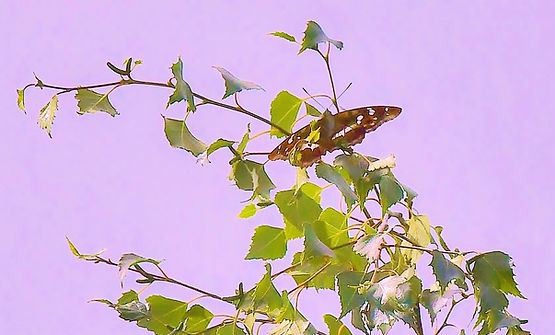
.jpg)
New Forest Hawkhill Inclosure and Beaulieu Heath Field Trip Wednesday 28th June 2023
A lot cooler day for the field trip and with a glorious backdrop of the New Forest we were soon underway seeing our first Silver-Studded Blues many in very good condition, and also pairing up as well. In the woodland the Dark Green Fritillary showed itself feeding on the sparsely spaced Bramble bushes, and several White Admirals were seen, but oddly no Silver-Washed Fritillaries! In the Warts gutter stream there were numerous dragonflies and damselflies, the highlight of these were the Golden Ringed Dragonfly, and several females were observed laying eggs.
In the afternoon we were fortunate to see the Heathland in all its glory now the sun was shining, and the Silver-Studded Blue count shot up. We were fortunate to stumble upon a rare Clouded Buff Moth, which posed quite nicely for us. On the way back we came across one of the first emerged Grayling butterflies, just by the car-park, my first encounter with one of these butterflies in June I think! I would like to thank all who came and made this a most enjoyable field trip.
.jpg)
.jpg)
.jpg)
.jpg)
.jpg)
Old Winchester Hill Field Trip Wednesday June 25th 2023
On probably on of the hottest days of the year where there wasn’t many hiding places the butterflies were somewhat disappointing. There were a good few Marbled Whites and Small Heaths, and the fast flying Dark Green Fritillary for our efforts but there were very little else, although freshly emerged Small Tortoiseshell was seen on the car-park down in the bright sunshine. It was far too windy to see if there were any White Letter Hairstreaks on the Elms. In the Coombe, there were a token few Silver-Washed Fritillaries, Speckled Woods and Ringlets. We were hoping for a Chalkhill Blue outbreak but it wasn’t to be, as the other blues have all disappeared. I thank all who came and braved the heat!



.jpg)
.jpg)
.jpg)
Broxhead Common Thursday 22nd June 2023
A short visit to this site to see the Silver Studded Blue, on the way up to Alice Holt Forest. In this weather the blues were constantly on the go, but the count was quite impressive with up to a hundred seen in about an hour, but there was very little else of note, one Lattice Heath Moth, Small Copper, and Meadow Browns. The Bell and Ling Heather looks impressive in its Purple Colour and there were several female Silver Studded Blues laying their eggs on the foodplant.
.jpg)
.jpg)
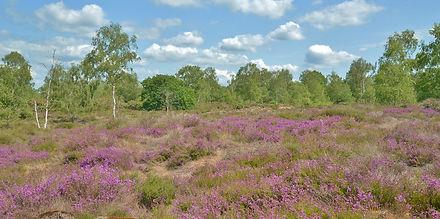.jpg)
Oxenbourne Down Wednesday 21st June 2023
After a week abroad in Sicily where it wasn’t as hot as the UK at the time, it was nice to get back just in time as the Purple Emperor season seems to have just kicked off in Hampshire. Several were seen today one at Straits Inclosure, and another at Longstock Stockbridge.
Today I visited Oxenbourne Down just to check out the Dark Green Fritillaries and I’m pleased to say they were on the wing although not in great numbers, about a dozen or so seen, several feeding on thistles. The Marbled White was in great numbers and they are still emerging. The blues seemed to have disappeared quickly in this heat. There were still good numbers of Small Heath, Meadow Brown, and Large Skippers are building nicely.
.jpg)
.jpg)
.jpg)
.jpg)
.jpg)

.jpg)
Coulters Dean Field Trip Wednesday 7th June 2023
Never known a spring like this one with sunny periods and a constant North-Easterly breeze blowing off of the North Sea and at times today it was quite hot. There were hundreds of 5 spot Burnet Moths seeming on every plant with nectar and few Small Blues were in the mix with the last of the Green Hairstreaks and Dingy Skippers, also showing were Burnet Companions in good and faded condition. The lovely carpet of Cowslips has now gone over, making way for the many Orchids that abound this site. We even saw the rare Cheese Snail today, a speciality in this area, although there not easy to find!
.jpg)
.jpg)
.jpg)
Bentley Wood field trip Sunday 4th June 2023
A field trip to a place I used to love which is sadly in decline and has been for many years, although it’s not conservation work or management to blame, it’s the weather and global warming to blame I fear. Eastern clearing is now so dry and there are so few wild flowers, in the rides or in the meadow.
Once you used to see the Pearl Bordered Fritillary in great numbers but sadly have been reduced to an alarming few now we did manage to see about 6-8 individuals all in poor condition, as they have been flying in exceptional warm weather for well over a fortnight now. We did see (16) butterfly species but there was a good amount of moths as well, with Long Horn Moths, 4 dot Footman, 5 and 6 spot Burnet Moths, Cinnabar Moths, Silver ‘Y’ Moths, Drinker Moth larvae, Common Carpet, Speckled Yellows, Yellow Shell, Mother Shipton, Burnet Companion, and Brown Silver-line.
We walked to the Elm tree area in the afternoon, but sadly these are succumbing to Dutch elm disease, although several trees seemed to be OK in their present state. There were some leaves that had evidence of White-letter Hairstreaks being present, and some sallow was seen with evidence of Purple Emperor larvae damage.
.jpg)
.jpg)
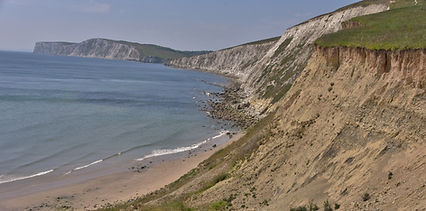.jpg)
.jpg)
Mottistone Down Isle of Wight Wednesday 30th May 2023
Setting off on the ferry the forecast was good weather but the wind was still very keen and the clouds were still in evidence. However once we got around to the southern side of the Island things began to pick up and the sun shone even though it still felt cool. Visited the small car park at the bottom of Afton Down first but the weather wasn’t good at this time with the wind and there was very little of note a Large Skipper or two and the odd Common Blue. Once on the down the sun was out and the wind had abated, and in the chalk pits of Mottistone we were in our own little world.
The Glanville Fritillary were everywhere, and it was hard to count them but guestimate was up to 40 plus. They were very active, however I didn’t see any females and their foodplant was rather scarce, but it must have been around. Common Blues Small Blue, Brown Argus, Dingy Skipper the odd Grizzled Skipper, Large Skipper, Green Hairstreak, and Small Heath, added to the totals. The Moths there were Silver ‘Y’, Common Carpet, Speckled Yellow, Cinnabar Moth and Burnet Companion.
Other sites visited were Afton Down again, where the odd Adonis Blue was noted along with Wall Brown and Small Blue. But the Glanville was again the most populous butterfly, flying amongst the Rock Rose and Horseshoe Vetch stands. The Ribwort Plantain was everywhere here along with a host of other plants but parts of the down seem to be getting rather overgrown; although I only saw a fraction of this downland other parts are probably very short turf which would be more of the liking for the Adonis Blue, especially in front of the Military road facing south where there is good amounts of Horseshoe Vetch.
.jpg)
.jpg)
.jpg)
.jpg)
.jpg)
Martin down Friday 26th May 2023
Visiting Martin Down on such a perfect day, well there was a stiff wind blowing at the start of the walk, and there was very little seen. However once we had changed direction many of the Small Blues and Grizzled Skippers and Brown Argus’s started to appear along Bockerley Ditch. A baby Adder was seen under a tin shelter near to the rifle butts, and there were lots of Skylarks flying high over the downs.
In the fields where the farmers were cutting the grasses for silage, and there were lots of Red Kites and Buzzards flying in very low in and around the ditch and fields looking for insects and other potential prey disturbed by the tractors. (17) Species of butterflies and a few moth species were seen, these being mostly along Bockerley Ditch. Every Hawthorn bush seemed to have a Green Hairstreak or two. Fresh Adonis Blues were just starting to fly and these looked very pristine... Small Blues were everywhere once I got my eye in, unfortunately I never saw a Duke of Burgundy but these are quite rare here, so you have to be very lucky to see one.
Martin down Field Trip Sunday 28th May 2023
Despite it being a hotter day today at Martin Down the species count wasn’t as good, although the moths seemed to be better. With an excellent turn out today we beat a path towards the Rifle butts and we saw our first Marsh Fritillaries along with many other species. There were plenty of Skylarks in the meadows and Corn Buntings and Stonechats in the hedgerows. A Cuckoo was heard almost all of the time we were walking around but we never got a glimpse of him. In all 19 species of butterfly were seen along with at least 10 species of moth including Forester Moth and Wood Tiger Moth. Good Adonis Blues were battling with Small Heaths and Common Blues, but the Green Hairstreak didn’t seem to be as common as Fridays visit.
I would like to say a big thank you to all who came and made this a most enjoyable field trip.
.jpg)
.jpg)
.jpg)
Stockbridge Down Field Trip Wednesday 24th May 2023
Probably the hottest day of the year with little or no cloud cover as we set off over the down, with rising temperatures it still took an hour or so before we were chalking up good numbers of invertebrates. Like most sites this year the Holly Blue seemed to be quite common and when we got our eye in the Green Hairstreak was extremely common, along with Grizzled Skipper. Other species of note were Brown Argus, more Common Blues certainly living up to their name, Orange Tips were in evidence after a short absence. Moths of note were the Yellow Shell, Common Carpet, Silver-Y and the 5 Spotted Burnet Moth.
At Woolbury Hill the Duke of Burgundy was in evidence but the Cowslip count there is rather thin on the ground, but it was nice to chalk up another site for the species. In all we had 16 species of butterfly and 5 or 6 species of moth.
We didn’t see the Adonis Blue today but I suspect it won’t be long before they have emerged here, and the Pearl Bordered Fritillary has now gone, but there is a faint hope it will return with management of the site.
%20(2).jpg)
.jpg)
.jpg)
.jpg)
West Wood Pitt Down Field Trip Sunday 21st May 2023
A chance to see the Woodland Duke, which is such a rare event these days. A small copse in West Wood has a medium number of these delightful insects, in in a plantation amongst small and medium sized Oak, Beech and other natural woodland trees. The trees are starting to get quite tall in places and it won’t be long, maybe five or more years that the undergrowth and especially the Primroses will be shaded out, and the Duke colony may be lost.
However The Forestry Commission have started to cut a ride through the plantation and over to the eastern side of the wood, and here in amongst the shrubbery of Bramble, Wood Spurge, and other plants it was good to see about four males interacting with each other. It is hopefully planned that this will continue into Crab Wood and the Duke should have a safe corridor from West Wood into Crab Wood.
Pitt down Sunday 21st May 2023
There wasn’t a lot to see on Pitt Down it is getting quite overgrown in places with Dogwood and other shrubby plants, even though there are Ponies grazing on the site. We saw many Holly Blues, which the butterfly of the year at the moment with several seen in and around the Dogwood plantations laying eggs. Several Green Hairstreaks were seen, along with Grizzled Skipper, and Small Copper. There were many moths to be seen like, Treble Bar Moth, Mint Moth, Burnet Companion, Cinnabar Moth, Mother Shipton, and in the wood the Drab Looper could be seen flying about.
.jpg)


New Forest New Copse Inclosure and Pig Bush Field Trip 17th May 2023
A warm day in a new part of the New Forest, although not a million miles away from Pignal Inclosure, where I normally I go for the Pearl-Bordered Fritillary. The Pearl-Bordered Fritillary was out in good numbers once we all got our eye in, there were several females seen egg-laying in the scrubby leaf litter, and the slopes of the rides were covered in Common-Dog Violets. The woods at the moment I think look their best with the leaves still not turned a dark green colour, which signals summers arrived.
Many of the male Pearl Bordered Fritillaries were in excellent condition, but they were very active only feeding on Bugle plants momentarily, before flying off and seeking out any unmated females, which seemed to be quite common in the undergrowth. In the Hawthorn bushes dotted around the rides the magnificent Rose Chafer beetles were busy feeding on nectar and mating. A new generation of Speckled Woods were dancing amongst the sunlight rides as we walked along and the bird song was tremendous, with one Cuckoo heard before the field trip started. In the end the Pearl –Bordered ruled the rides, and we all went away happy.
In the afternoon it was decided to go and look for some more Emperor Moths of which we did at Pig Bush in an area of excellent heathland habitat. Once on a small hill the pheromone lures got to work and it was about five minutes before we were ‘buzzed’ by at least half a dozen of these magnificent moths. An excellent way to end the field trip, and I want to thank everyone who came.
.jpg)
.jpg)
%20(2).jpg)
%20(1024x683).jpg)
Field Trip Old Winchester Hill Sunday 14th May 2023
A good turn out today and it always seems to happen when the species don’t seem to want to come out to play. The mist cleared just as we started off at 10:30 but the weather didn’t seem to have any influence on the species count especially in the morning as the temperature played a part. We really did struggle to see anything in the first hour or so, a couple of Small Coppers and a Dingy Skipper or two.
In the afternoon the weather was a lot warmer, and the species count had gone up, we had encountered our one and only Duke of Burgundy, Small Heath, Common Blue, Grizzled Skipper, and Green Hairstreak were all out by now and several species their the numbers were getting higher. By the time we had got close to car-park where we rested after climbing up the slope, here we counted several other species like Orange Tip, Holly Blue, and Speckled Wood.
We also had several Kestrels on the hunt, Red Kites and Buzzards, Chiffchaffs were chiffchaffing in the hedgerows, Yellowhammers, and Dunnock sang a decent melody in the thickets. Sadly there were no Cuckoos heard or seen, which is very worrying. On the moth front I saw several Silver Y Moths, Mint Moths, but the Emperor was not to be seen, so my bait may be wearing off a bit by now. I would like to thank all who came, especially the new faces may it continue, and look forward to seeing you all in the New Forest on Wednesday.
.jpg)
%20(454x684).jpg)
.jpg)
Emperor Moth in the rain on Oxenbourne Down 10th May 2023 Despite cancelling the field trip and the gloom and showery conditions I decided to risk a visit to Oxenbourne Down today. There was mostly black clouds and a few gaps where the the sun shone through keeping the temperatures up to a reasonable level. When the showers started it was just a very light shower, and I was surprised what I did see, Red Admiral (2) Peacock (1) Duke of Burgundy (15) including two females amongst the Cowslips. (8) Brimstones, (1) Small White, (1) Holly Blue (1) Dingy Skipper (4) Grizzled Skippers, and last but not least an Emperor Moth buzzing around me attracted to my Lure which is still attached to my Camera Bag. It landed on my trousers, an my Lure itself, but it still flew away unable to ascertain where the pheromone was. So I've seen this beast now at Broxhead Common, Oakhanger, Butser Hill, and Oxenbourne Down.
.jpg)
.jpg)
.jpg)
Butser Hill Field Trip Sunday 7th May 2023
The field trip was nearly cancelled, the weather was going to be cloudy up to about 2:00 pm, and with a field trip starting at 10:30 am were we going to find anything? I needn’t have worried the just immense vista that greeted us as we walked around the rim of Butser Hill admiring the ‘millions’ of Cowslip plants all stood to attention in a still atmosphere, along with many Early Purple Orchids, and finding many caterpillars of the 6-spotted Burnet Moths crawling along the lush green chalk downland, looking for somewhere to pupate no doubt. We got to the bottom of the slope and there wasn’t much to see, except one Duke of Burgundy had managed to emerge from the gloom of the cloudy skies, and it was warming up by the time we took lunch, and then the skies parted forcing the Sun to do its duty and away we went on a counting spree. With the ever present twitter of Skylarks and the Yellowhammer singing in the distance we were disappointed by no singing Cuckoo, which is normally a presence here in the bowl of the site.
By the time we had started to ascend the slope to go home we had notched up (25) or more Duke of Burgundies, many Brimstones, dancing in pairs in the warm sunshine, Grizzled and Dingy Skippers, Green Hairstreaks, Red Admirals, Peacocks, lovely Orange Tips zipping through not stopping, several Small Coppers, in all 11 species of butterfly. On the moth front we saw several Silver ‘Y’ moths, several Mint Moths, and to crown it all two Emperor Moths, these had been alerted by my ever present ‘lure’ still attached to my camera bag. We had one at Grandfathers bottom, and I had one in the car-park just as I was preparing to go home. In all it didn’t turn out too bad I thank everyone who came, and Butser Hill is still just as unforgiving, but we all made it, and we have to be thankful for that!
.jpg)
.jpg)
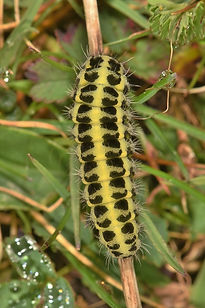.jpg)
.jpg)
.jpg)
Oxenbourne Down Wednesday 3rd May 2023
A rare event today a warmish day without much cloud, just a breeze and the Duke of Burgundy turned up. (8) Were observed over a period of two hours which sounds rather poor, but they have only just emerged, and on a site like this it’s very difficult to find as they are very spread out, and the dreaded Dogwood is raising its ugly head over much of its range.
The Cowslips are definitely looking healthier, and several female Dukes were seen in the area, testing the leaves ready for egg laying at a later date. One male and female were seen trying to copulate, but looking at my photos later it would seem the female may well have had a deformed, or damaged abdomen so she rejected his advances, anyhow I don’t think she had ovulated, as the abdomen is normally quite fat full of eggs when they mate, and this certainly wasn’t the case.
Other species seen for the first time this year were, Small Copper, Grizzled Skipper, Large White, and Green Hairstreak. It was nice to get (11) species on the board.
.jpg)
.jpg)
.jpg)
Portsdown Hill /Southwick Estate Tuesday 1st May 2023
Somehow I don’t think it’s going to be a Duke of Burgundy year, with only a small window of opportunity to fly, the weather at the moment seems to be rather cruel. Today it was more traditionally April weather with showers and small spells of sunshine. Went up to Portsdown Hill to see the Woodland planted 40 years ago as a Falklands memorial and to see some bluebells there, however there wasn’t any bluebells, which was quite a disappointment. I then went over the hill to look at some woodland on the Southwick Estate, which is a massive Estate and has been in the ownership of the Thistlethwayte family for nearly 500 years – over generations, they have run the 8,000-acre agricultural estate centred on the village of Southwick in Hampshire. Butterflies there were a couple of Speckled Woods and some Small Whites feeding off of the Bluebells and Garlic Mustard. The Bluebells were a picture and so was the Garlic Mustard. On a lake there was a Grey Wagtail feeding on flies which was a highlight today.
Purple Cloud Moth seen on the Isle of Wight
Purple cloud!! Bonchurch Isle of Wight 30.04.23. So lucky that another amazing moth has come to my garden mv, and it is so beautiful as well. A very attractive species, this moth is a rare migrant to Britain, having occurred about 20 times. Most of the records appeared on the south and south-east coasts in May or June.
The species is fairly common in continental Europe, where there are two generations between May and August. The larva has not been recorded in Britain, but abroad it feeds on St. John's-wort (Hypericum).
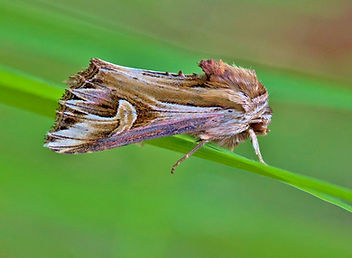
.jpg)
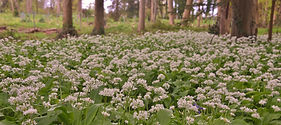.jpg)
.jpg)
Oxenbourne Down Saturday 29th April 2023
Another visit to see if the Duke of Burgundy had emerged and it seem that it hasn’t yet, but a few days like today and it should be emerging, as it seems very odd that we haven’t had the presence of this delightful butterfly at most sites in Hampshire yet despite the fact we are right at the end of April. Last time I came up to Oxenbourne I was greeted with a nil count, today was totally different, the warming temperatures soon made a difference and I was soon seeing (6) Species with counts of Peacock (10), Comma (2), Brimstone between (30-50), Small White (1), Orange Tip (8) and Holly Blue (2). Highlight was watching the female Brimstones laying their eggs, (see photographs)
%20(618x1024).jpg)
.jpg)

Milton Allotments and Milton Foreshore Friday 28th April 2023
A warmer day and on my local patch the species count of butterflies was (7) which is roughly were it should be at this time of the year, highlights were the Painted Lady and several Peacocks. Green Hairstreaks have been seen on the Isle of Wight, but not the usual species for the end of April, well not yet anyway, as there is a High pressure system coming in which should keep the temperatures a bit higher. This time last year we were in the middle of a mini heatwave
.jpg)
.jpg)
.jpg)
.jpg)
.jpg)
.jpg)
Oxenbourne Down and Portsdown Hill Tuesday 25th April 2023 – Where are all the butterflies?
Good weather today despite the breezy conditions which took the top off the temperature as it did feel quite cool at times. I proceeded to go to Oxenbourne Down and here there was very little to see certainly no butterflies, which must have been a first for me….almost the end of April and the butterfly count was zero, just how can this be? I managed to see a couple of slow worms; I just hope May is a good month! I then went to Portsdown Hill and went around the back of Fort Widley and was struck by how the Cowslips have taken over in the meadows, looking a picture. I managed just three species of butterfly which was hard work, one Small White, one Small Tortoiseshell, and last but not least on the way down past the hospital I espied a female Orange Tip…hurrah!
Noar Hill / Oakhanger 20th April 2023
Today was Duke of Burgundy day with one male being seen in one of the large flint pits. However after leaving Noar Hill Jackie and I decided to go for some lunch at 'The Chocolate Frog' for Tea, and after we had finished Jackie decided to look around the few shops there. I decided to go back to the car and take a few Photographs of the surrounding area. I opened the boot of the car and my Emperor Moth Lure was still attached to my bag from yesterday's field trip. After taking a few photos of the area, Jackie came back to the car and shouted 'butterfly! er no it wasn't it was a randy male Emperor Moth and he had detected my Lure and was flying in and out of my boot of the car , up my trouser leg, I even managed to cup him in my hands, but he escaped, and sat on the tarmac for a minute or so, where I was extremely lucky to get a few shots of him...better than yesterday where they were so frenzied in an attempt to find the female Emperor Moth. It was an area I would not associate with Emperor Moths, however it isn't a million miles away from the Heathland where I was yesterday, so it was a great surprise and joy to find my lure still worked, even when I had forget it was there!

.jpg)
.jpg)
.jpg)
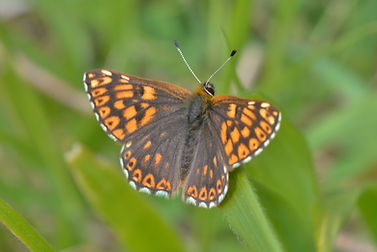

Noar Hill Wednesday 19th , Thursday 20th, Broxhead Common Field Trip A third time of asking at Noar Hill today but success at last with my first Duke of Burgundy which was in one of the first pits you come to from the South-Western end. I have been there three times and today was obviously the best day weather wise. Two Dukes had been seen on the 18th April but yesterday's weather was so cool and windy I don't think they were about. On the field trip front it was nice to see everybody again at Broxhead Common after a 7 month break. We were successful in seeing the Emperor Moth however that's all we did see, as the weather was very cloudy and quite cool. One was seen in the morning and one in the afternoon, both were very agitated and would not stop flying around our lures and on my camera bag and other places where they thought there was a female. Other interesting flora fauna seen were Kites and Buzzards, Wood Larks and Stonechats, along with a Slow Worm, and Toadstools. It was very early for Toadstools and I put this down to the very wet weather we have had over the past few months.
.jpg)
.jpg)
.jpg)
Noar Hill Tuesday 18th April 2023
A blue sky but a keen wind greeted me as I entered Noar Hill, but when the wind abated for short periods it was really warm, but I could just tell it was going to cloud over by mid-day and it did. Butterfly wise it was very poor, Three Peacocks, Several Brimstones, and one Small White. If the Duke of Burgundy was anywhere it was not very evident, especially in the keen wind. I feel there is another week yet but we do need some warm weather to kick start its season. The site has had a lot of Blackthorn removed, and many of the pits have been laid bare for more re-generation of Violets and Cowslips to grow. I saw several Yellowhammers, and Red Kites were cruising over the site on the hunt. On the way up and back I don’t know how many dead Badgers I saw on the edge of the roads a very sad sight in this day and age, something that’s certainly not acceptable especially as they have young now.
.jpg)
.jpg)
Its that time again the field trip season is almost upon us. If you haven't tried it then it's time to give it a try. Make new friends and learn some new facts on flora and fauna of Hampshire and the Isle of Wight. Field Trips are for everyone, and I would like you to come along, novice or expert. Photographers, children (with adult supervision)and first timers, You are all welcome! Please wear suitable footwear and please bring a packed lunch. Walking over rough ground could regrettably make it difficult for those with mobility issues. Please check with me if in doubt. The branch field trips are on page 24 of the April Newsletter.
Milton Allotments and Foreshore Saturday 15th April 2023
A small window of bright sunshine and warmth from the sun paid dividends today along my local patch with (4) Small Tortoiseshells, two of which were a courting pair and also a couple of Peacocks one of which looked as if it had had a bird strike, as it was torn in the same fashion on both wings. There are lots of Small Whites now being seen, but alas still no Orange tips in my area.
On the Island there has been reports of two Clouded Yellows, these are possibly migrants from France on the strong winds coming across the channel at the moment.
.jpg)
.jpg)

Milton Allotments and Milton Lock Nature Reserve Thursday 13th April 2023
Weather is still cool in the windy showery weather and I caught a small window of sunshine yesterday walking around , however there wasn't much to get excited about, a couple of Speckled Woods, a courting pair of Small Tortoiseshells, and of course the Small Whites were starting to come out in good numbers. Orange Tips are starting to appear but not very evident as yet as was the Holly Blue as well.
.jpg)
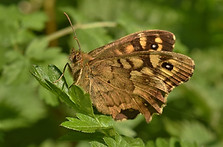
.jpg)


Broxhead Common Sunday 9th April 2023
Visited one of my favourite sites today in the last of the good weather for a while, and its rather a hit and miss affair trying to bait the Emperor Moth as you just don’t know how many if any are going to turn up…although I’ve had a 100% success rate here and in the New Forest over the years. Arriving at 10:30 and after about 5 minutes a male was flying in circuits around us. He unfortunately didn’t stop and was totally confused with my pheromone trap as after about 10 minutes of flying around he flew off never to fall for that trick again…today at least! We put the trap in several different areas but no luck…so my theory is it’s rather, early for these at this site, or my trap is not working to its full potential as I’ve had it for several years now. There were several Brimstones seen and Peacock and Small White, but very little else.
Photo Holly Blue A. Thornbury
.jpg)
.jpg)
Portsdown Hill Thursday 7th April 2023
Lovely weather over the Easter Bank Holiday should kick start a few species into action, meanwhile on Portsdown Hill the migrant birds are in song Chiffchaffs were noted and many Skylarks along with Yellowhammers and other small birds. There was a distinct absence of birds of prey, but I was impressed with the good clumps of Hairy and Common Dog Violets on the downland and small areas of Cowslips beginning to appear. Meanwhile on the Isle of Wight there has been another report of Large Tortoiseshell, these are in good condition (see photo) suggesting they may well be home grown specimens, obviously hibernating throughout the winter.
Today at Milton Common I saw my first Speckled Wood Butterfly.
.jpg)

.jpg)


:Photo Large Tortoiseshell Nikki Kownacki
Its time for the Duke of Burgundy to appear normally being seen in April, with warmer weather hopefully it should appear somewhere in and around mid-month at the usual sites in Hampshire. Other butterflies on the wing are the Large Tortoiseshell seen on the Isle of Wight this week, and the Holly Blue along with the Orange Tip being noted. Its going to be good weather over the Easter holiday so I expect a flurry of reports on the media, so keep tuned in!


East Meon Monday 3rd April 2023
After the wettest March for several decades it was nice to get out and about in warm sunshine in the South Downs National Park again today at Park Hill close to East Meon. On the thermals were numerous Red Kites with a splattering of Buzzards and a couple of Kestrels hovering over the down. Disappointingly the wild flowers seem to be very slow this year, probably due to the cool and damp weather we have been having lately. There were good clumps of Wood Anemone and Primroses, but other plants haven’t shown themselves yet. On the Celandine there were Small Tortoiseshell and an odd Peacock but the butterfly of the day was the male Brimstone which was everywhere in the bright sunshine, only stopping very briefly to refuel, the count being in excess of twenty, plus.
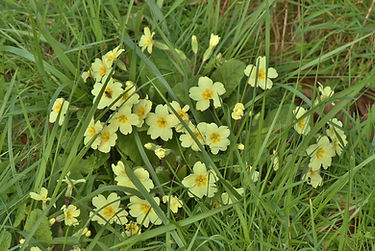.jpg)

.jpg)
.jpg)
.jpg)

Wonderful to see male Emperor Moths (Saturnia pavonia) beginning to emerge. He will need all the surface area on his antennae that he can muster to pick up the scent of the females in this wind!
Male Emperor Moths are starting to emerge in the New Forest.....
I will be running a Field trip to Broxhead common especially for this species keep an eye out in the Newsletter and website for up dates!
.jpg)
.jpg)
Portsdown Hill Monday 27th March 2023
March has been one of the wettest months I’ve known, a far cry from 2022, and today was the first time I had seen the Brimstone butterfly about 5 or 6 in total with a couple of females as well, along with the Peacock and the Small Tortoiseshell for good measure. I was expecting more butterflies but the sun wasn’t out all the time, but when it did shine it was really rather warm. On the bird front there weren’t any Peregrines to see, but there were a couple of Buzzards, and a couple of Red Kites soaring over the downland. The wildflowers were disappointing as well as the down had been mown, to cut down the fast growing Dogwood, but there were some Violets seen but no Cowslip or Primrose.
.jpg)
.jpg)
.jpg)
Hummingbird Hawk Moth. Just disturbed a Hummingbird Hawkmoth hibernating in my garage - an unexpected sighting. It buzzed around for a few minutes then settled back into a crevice in some stored seat cushions. [Posted by Paul Warren]
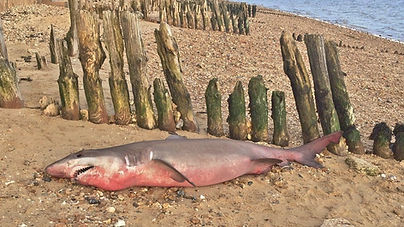


Doings in Hampshire over the past week
With no ending of this weather a constant drift of cloud and windy weather and good amounts of showers as we desperately need the rain it’s been a funny old week in Hampshire. On Lepe beach the body of a shark, believed to be a small - tooth sand tiger, was found by walkers on Saturday and was seen by the broadcaster, Dan Snow. Before you know it somebody hacked off its head and tail before any scientific research could be done on it. Also a couple of days ago an Osprey was seen overflying the New Forest, which is very early by reckoning, probably one of those heading north maybe to the Scottish Lakes or Rutland water maybe, as they always return to the same site year after year.
In and around Hampshire there have been odd sightings of Peacock and Brimstone butterflies and the wildflowers are showing well with good amounts of Violets and Primroses. In the Moth traps there have been some good sightings especially on the Ilse of Wight. Jim Baldwin ran the 125W MV trap for the first time this year on Saturday evening and was rewarded with my first migrant moth of the year, a Dark Sword-grass (Agrotis ipsilon). Other moths recorded were Hebrew Character x3, Common Quaker and my first Clouded Drab of the year.
.jpg)


Jim Baldwin has had an Oak Beauty Moth in his light trap on the Isle of Wight An unmistakable moth of early spring, they can be found in mature oak woodland and even gardens where broadleaved trees such as oak, hazel and elm grow. Adults are sometimes found freshly emerged at the base of tree trunks, along with early thorn moth and a a Hebrew character, Also the Peacock butterfly has been seen, along with several Brown Hairstreak eggs on Portsdown Hill on Blackthorn by Mark Tutton
.jpg)


Milton Allotment and Foreshore 14th March 2023
Another rather warm day and on the Allotment at Milton a female Red Admiral was seen sunning herself and proceeded to lay a few eggs on the Nettles which were just starting to grow. A couple of Foxes were also seen sunning themselves, and just allowed me to take a couple of shots before they thought I was going to get too close. Along the foreshore the tide was coming in, but the Brent Geese were giving some good flying displays, which will soon be missed as they will be flying home very soon.
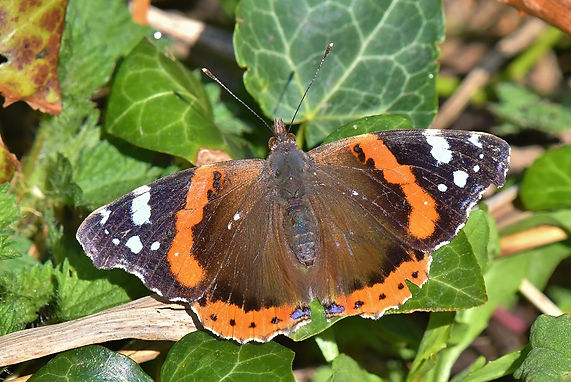.jpg)
.jpg)
.jpg)
Winters return with a vengeance
A lot has happened in the Hampshire and Isle of Wight countryside over the past few weeks with the weather turning rather cooler, although with global warming anything can happen! The snow returned like the ‘beast from the east’ and there was a fair bit of covering in the north of the county and parts of the South Down’s like Butser Hill, Old Winchester Hill and Beacon Hill got a load of the white stuff as well. Then came the strong winds a few trees succumbed to the gale and the tides being whipped up into frenzy especially in and around Portsmouth, and along the coastal region of the Isle of Wight. In the garden the Crocuses are attracting Honey Bees but the butterflies still lay rather torpid waiting for the wind to ease and get much milder especially at night, although some moths are taking flight. The birds don’t seem to be put off by much of this the Brent Geese are preparing to go home and the Shorties in and around the county are still giving good account of themselves. Winnie the female Peregrine and her mate have made a few noises on the Winchester Cathedral to making another family, and there have been reports of Peregrines closer to home just along from Portsdown Hill which may be worth investigating.






.jpg)
Milton Lock Nature Reserve Monday February 27th 2023
Just as we thought spring may have sprung then along comes along another bout of cool weather, and next week is forecast to be even cooler, with threats of snow another ’beast from the east’. Just locally again today and I had a look at the planting of shrubs and trees which have been planted by the council, on Milton Lock Nature Reserve. I didn’t look too closely at what had been planted; I just hope they are all native to this country. The photo of the Redshanks taken along the shoreline as the tide was coming in was a delight to see, as they stood on one leg and went to sleep, these tend to use the small stony spits which stick out along the foreshore opposite the Allotment.
.jpg)
.jpg)
.jpg)
.jpg)
Winnie returns to Winchester Cathedral
It’s time to start looking for your local Peregrine Falcons especially on tall buildings like Cathedrals, Churches, Pylons Cliff faces and high urbanised buildings like Tower blocks and industrial units. Winnie and her mate were successful in 2022 let’s hope they can breed in 2023, and just along the coast is the most famous Peregrine in the South of England on Chichester Cathedral, where they have been for many years now. The off spring have found successful territories along the coast, and one site is at Portsdown Hill where I have seen them.
.jpg)
.jpg)
Meonstoke and other notes Feb 15th 2023
Warm splash of spring sunshine has brought about a spate of sightings of early butterflies, Small White, Peacocks, Commas, Small Tortoiseshells, even Painted Ladies and Brimstones have been seen on the Isle of Wight, in and around Winchester, and at Creech Wood. I saw a lovely Small Tortoiseshell feeding on Heather today along with multitudes of Honey Bees, Crocuses, and lots of Snowdrops were really putting on a display. It will be interesting to know if the Large Tortoiseshell puts in an appearance, one was reported on Facebook yesterday at Lower Normandy, whether this is France or in Hampshire I suspect I shall find out soon enough.

.jpg)

.jpg)
Hummingbird Hawk Moth seen on the Isle of Wight!
This week in the news from the Isle of Wight at Sandford Jo Boddington has seen a Hummingbird Hawk Moth, which as she says must have been hibernating, although there is a possibly of some coming over from the Continent with this high pressure area centred over the area at the moment. Anyway it seems to be one of the earliest sightings. The Photographs are mine from the summer, a male at rest which is quite unattractive to say the least, and this is probably where they are overlooked on plants, being cleverly camouflaged.
East Meon February 10th 2023
A Beautiful day with little wind and a walk up and over the downs, and the bird life didn’t disappoint. Where over the last few weeks I have very seen little out and about and nothing in the garden it certainly made up for it today. Red Kites were spiralling upwards behind East Meon church about a dozen in all, and further along there were good amounts of Buzzards as well. In-between where the stubble was dying off there were hundreds of Skylarks flying in flocks, and also noted were good amounts of Chaffinches as well, both flocks flew separately, and I only identified these when I got home and looked at the photographs. In the sky there were thousands of Crows, I hadn’t seen this many before, some were interacting with the Red Kites and Buzzards, as they were spiralling upwards on the updrafts. In the church grounds the Snowdrops were out and looked splendid, however the Violet’s and Primroses were not out yet and there weren’t any Daffodils either, but another few weeks, and I will hopefully see the first signs of butterflies about when the Spring claims its territory.
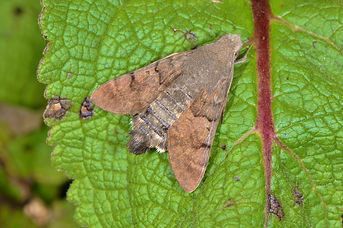

.jpg)
.jpg)
.jpg)
.jpg)
.jpg)
Milton Foreshore and Portsdown Hill February 6/7th 2023
Warm spring sunshine at the beginning of February very similar to last year, but this year there seems to be a lot less about. Up at Portsdown there were very few birds about, Skylarks were singing over James Callahan Roundabout area, and up at the western end there were several Peregrine Falcons, and at least a half dozen Kestrels on the hunt, but very few birds in the hedgerows. I did see my first butterfly for 2023 a Red Admiral. Down on the Milton Foreshore there were many Brent Geese feeding on the University grounds, and Gulls, and Mute Swans paired up but very little else, unless you like Rats which I’ve noticed have increased immensely since Covid, where they have got a lot braver moving about under our feet.
.jpg)


.jpg)
Several Spring Usher Moths have been seen on the Isle of Wight a variable patterned species of moth which lives in Oak woodland, and will readily come to a moth trap. They were seen in the Shanklin and Cranmore areas of the Island. I’m surprised there haven’t been any reports from the mainland unless I’ve missed them. If you haven’t already got the Moth trap ‘bug’ then now’s the time to start as the weather warms up and the night time temperatures become warmer then the numbers of moths will eventually increase.
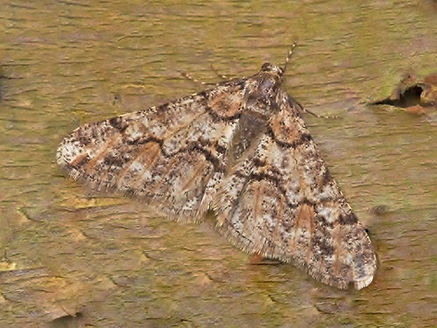

A weekend over to the Isle of Wight and I make no apology for the Red Squirrel photographs as they are so endearing and one of my favourite wildlife subjects, I took over a hundred in a friends back garden and they kept us entertained for well over an hour. Other species seen were Great Spotted Woodpecker, and many other garden birds like Great Tit, Blue Tit, Chaffinch Magpie, Long Tailed Tit, and Jay. I also learned that the Isle of Wight has no Tawny Owls, or Nuthatches, which really surprised me, as there is a lot of woodland on the Island, although this does not mean that these species have to be there, thinking of Purple Emperor springs to mind, although there could well be a colony or two hidden in plain sight (see Purple Emperor pages on this site). At Yarmouth the tide was out in the estuary of the River Yar and the wading birds were quite impressive, with many Redshanks, Turnstones, Knots, Egrets, Teal, Mallard, Pochard, and other birds I couldn’t readily ID, as the sun was in my eyes in the afternoon. The highlight of the walk around the old railway line and shoreline was a Kingfisher which was patrolling up and down the wear and in front of the old Mill building; I saw it a few times but didn’t hang around long enough for my liking…
%20(2).jpg)

.jpg)

.jpg)
.jpg)
A pair of beavers have been released as part of a rewilding on a former shooting estate.
Chompy and Hazel were introduced on the 925-acre (370-hectare) Ewhurst estate near Basingstoke, Hampshire.The semi-aquatic mammals, which were hunted to extinction in the 16th Century, create wetlands and wildlife habitat.Estate owner Mandy Lieu said she was "thrilled" to bring back beavers to the county after 400 years. Beavers were once widespread in Britain, but were hunted for their fur, glands and meat.
They are now found living in the wild on a number of rivers in Scotland and England, through official trials and illegal releases or escapes, and have also been introduced into enclosures in a number of English counties.
The Beaver Trust described them as a "keystone species" with the ability to improve entire ecosystems by kickstarting the natural processes needed to restore habitats and reverse species loss in an area.
.jpg)

All the shouting is from Havant at the moment at Southmoor Nature Reserve where there is a ‘wayward’ Sabrina’s Gull, which is way off course as it should be in North America, obviously blown this way by the wind over the last week or so. Also keep a look out for great flocks of birds, especially Godwits, Starlings, Lapwings, Dunlin, Oystercatcher’s, Plovers, and Avocets to name a few. Red Admirals are showing on sunnier days but the wind is still very bitter as its coming in from the north now. Snowdrops, Crocuses and Primroses are all showing in parks and gardens, and this indicates an early spring, although the winter hasn’t finished yet, February can be a very cold month, and we are due one.

.jpg)
.jpg)
I’m sorry I haven’t posted anything for a fortnight as I’ve come down with the dreaded Covid Virus, and this came on top of the Virus that was doing the rounds after Christmas as well! So my journey’s now are being just local, and of course restricted due to the torrential rainfall we are experiencing at the moment. Over the last couple of days when the weather has broken the birds are the only thing really active, although they have been quite restrictive. Lots of murmurations have been seen of waders like Dunlin and Sanderlings, along with good views of Short Eared owl, Bearded Tits Dartford Warbler and Marsh Harriers in and around Titchfield and Farlington. Winnall Moors has put on a good showing of Kingfisher along with Basingstoke Canal. Primroses are starting to flower now, and it won’t be long before the warmth of any sunshine will encourage lengthy bouts of flying by any hibernating butterflies, so look out for Brimstone and Peacock which are normally the first to be seen. Moths to be seen are on my pages of what’s to be seen in January.
The 2023 Field Trip programme has now been completed and is on the Field Trip programme page, so I hope to see some of you in the field this year, hoping it’s a good year, but not so hot.
.jpg)
.jpg)





.jpg)
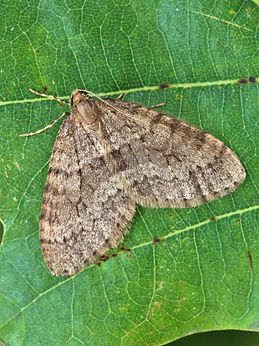
Happy New Year to all my readers!
It’s been announced that 2022 was the warmest year ever on record, and as I write this the weather outside is extremely mild for the time of year and more rain is forecast with gale force winds. The Weather has brought out a few butterflies which by rights should be hibernating, Red Admirals, and Peacocks have been seen, and also the Mottled Umber Moth along with the Winter Moth as well. This is a good time to have a look at the blackthorn thickets up and down the county, to look for Brown Hairstreak eggs, which I’ve posted here in close up looking like a sponge. On the bird front the Shorties are showing well at several of the bird sanctuaries I mentioned at the end of the 2022 blog page. Also the geese are now all here and feeding up well on the grasses especially in the Portsmouth area where they feed grassy areas close to Southsea beach and in the parks and grounds close to the Eastern road.
Hampshire & Isle of Wight Blog 2022
Short Eared Owls are now starting to frequent the south coastal bird sanctuaries. Places like Thorney Island, Hayling Island, The Ketch, Farlington Marshes, quite close to my home, which is always a thrill, to know they are there, although seeing one is the problem. Yesterday three were seen at Farlington Marshes, two actually engaged in combat. These birds will be in and around these sites now for at least to late spring, when they fly back across the North Sea to Scandinavia. They can see in broad daylight normally very early or late in the day, hunting for field voles. Other birds seen of note at many sites especially Titchfield Haven has been Dartford Warbler, Kingfishers, and Bearded Tits.
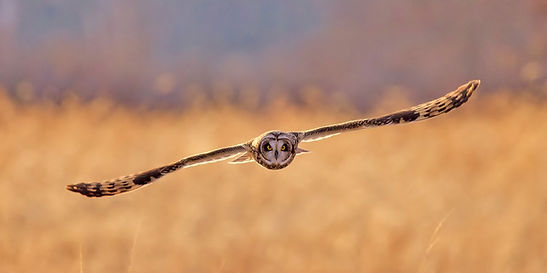

A walrus has been seen swimming and resting at a Hampshire beach.
The large creature, nicknamed Thor, was filmed by passers-by at Calshot in the early hours of Sunday (11 December).
Nobody knows if Thor is actually male or female because no one so far has been able to get close enough with a long lens camera to find out.
Walruses normally live in and around the Arctic circle and scientists say it is rare that they come this far South although there have been several instances over the past few years.
British Divers Marine Life Rescue scientists have tracked Thor for just over a month - logging his journey to the UK via the Netherlands and France.
Molly Gray, British Divers Marine Life Rescue, said: "This is the third walrus we've seen in the last two years - and the 4th in Europe - and we wouldn't have thought that the weather down here would be cold enough for them but I guess with climate change, things change and it seems to be becoming a bit more of a regular occurrence."
Advice for people who see Thor or any other walrus, is to keep their distance and leave them alone and give them space, as they can become aggressive if stressed.
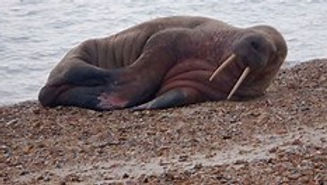

Titchfield Haven and Farlington Marshes will be my favourite haunts for the next few months giving me a break from the Butterflies whilst the winter does its best to blast us away with strong winds and cool temperatures. I've been to my local patch over the past week and seen many Oystercatchers and Curlews which are one of my favourite birds. I was surprised to see a Kingfisher at Milton Foreshore sitting on the Red Tide marker, he or she didn't hang around for a picture though.

.jpg)
.jpg)
.jpg)
.jpg)

Late Autumn in the New Forest
.jpg)
%20(1024x490).jpg)
.jpg)
.jpg)
Titchfield Haven 25th November 2022: A visit to this site in rather balmy weather, and there were lots of birds to see and even Dragon flies buzzing us! A Marsh Harrier was the highlight quartering the sky on the hunt over the reedbeds. Also, many Lapwings and its a few years since I've seen this many at one sitting! By the harbour wall there are many rats not everybody's favourite animal, but they looked good in a picture sticking their heads out and feeding on the scraps people leave the birds. Birds noted were Marsh Harrier, Snipe, Teal, Redshank, Oystercatcher, Lapwing, Turnstone, Mute Swan, Mallard, Shoveler, Long Tailed Tit, and possible Dartford Warbler. Strangely there wasn't any sightings of Egrets, Heron or Kingfisher.
.jpg)
.jpg)
.jpg)
.jpg)
.jpg)
.jpg)
.jpg)
Highlights from Titchfield Haven and Farlington Marshes in the past week have been sightings of Bittern, Marsh Harrier, Water Rail, and Bearded Tits, amongst a host of other birds too numerous to mention.



.jpg)
.jpg)

.jpg)
Weekend of November 12th 2022 : Over the weekend I attended the Butterfly and Moth Annual general meeting which was held in Huddersfield in Yorkshire, and coming from Portsmouth was a long way to go...however it was for an award ceremony for myself as I had been awarded the Outstanding Volunteer award for 2022 along with 8 other volunteers. These are for contributions to Lepidoptera conservation, in particular in my case for my work with the Duke of Burgundy and Purple Emperor butterflies, and my field trips over the last 10 years. There was interesting talks given throughout the day, and it's even been filmed for youtube, so anybody wanting to catch up on the latest events in the butterfly and moth world, and see what's going on in the UK and abroad then I would advise you to take a look.

.jpg)
.jpg)
.jpg)
.jpg)
Thank You to Jenny Craddock for letting me use her photo of the Speckled Crimson Moth (Left) seen at Winnel Moors, yesterday a rare migrant moth usually seen in the mediterranean or North Africa. There has been other sightings of this spectacular moth recently but only 200 sightings have been seen this century, so if you do see one it's imperative that its reported !



It ain't over till the fat lady sings.......In the news this week comes the sighting in a garden in Eastern Hampshire by Linds Edwards of a Long Tailed Blue, and also other reports of Clouded Yellow, Small Copper, and even a very late Wall Brown on the Isle of Wight. In my garden in Southsea Red Admirals are still flying around in the late sunshine.


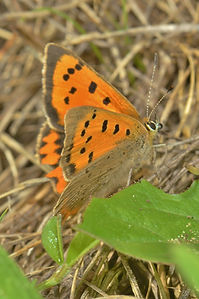

There is very little in the way of butterflies flying at the moment and as the weeks creep deeper into Autumn then the species and the counts are going to get less. I make no apology for the content that going on to the page now as the website is about Hampshire and Isle of Wight Flora and Fauna. Insects on the wing are large gatherings of Wasp especially around Stinkhorn Ivy, which has a lovely aroma at the moment with its sticky nectar. The Deer ruts are now in full swing in the New Forest and at other sites in and around the county, and as usual there are idiots out there getting far too close to the animals. It only a matter of time before a big beefy male Red or Fallow deer stag turns on somebody just trying to get that picture. On the Estuaries around where I live the Brent Geese are starting to come in from Siberia and other countries. At Farlington Marshes the Bearded Tits are showing well at times in the early mornings and Kingfishers are flying around the reeds, plus the odd Spoonbill have been seen. Short Eared Owls will soon be making an appearance also.



.jpg)
Autumn in Queen Elizabeth Country Park
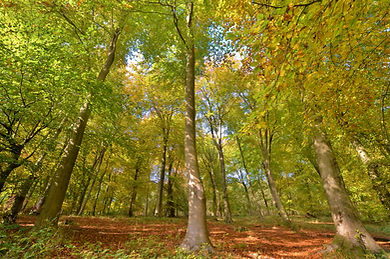
.jpg)


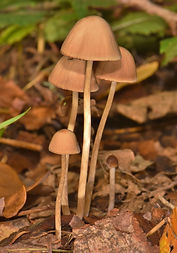

Sunday 10th October 2022 Eastney Beach Milton Allotments and home: Another warm day and a lst morning on Eastney Beach and the butterflies are getting very infrequent, with more Clouded Yellows still patrolling up and down the grassy embankment, with an odd Common Blue and lots of Small Whites as well. A move around to Milton Allotments and there were just the Speckled Wood in amoungst the woodland and the Red Admiral and Small Tortoiseshell were patrolling the Bramble line. At home there were Red Admiral and Painted Lady on my Buddleia which is just about finished.


.jpg)
Saturday 1st October 2022 Eastney Beach : Bright but breezy conditions greeted me on the eastern flank of my local beach and the Clouded Yellows were still in evidence with about 6 seen. They are unfortunately looking a bit tired now and they are so tame I even had one on my index finger. I even had a wasp photobomb the picture as the Clouded Yellow refused to move, however when the wasp decided to attack it it soon moved! Other species seen were a few Large Whites and a few Small whites, the Common Blues seem to have disappeared and the Small Copper still hasn't made an entrance. Along the beach I did see a couple of Common Terns patrolling up the shingle, which was a surprise.
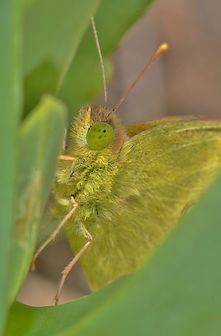.jpg)
.jpg)
.jpg)
Saturday 24th September 2022 Eastney Beach Up to eight Clouded Yellows still patrolling the beach at Eastney near Southsea today in the cooler breeze. Over 50 odd Small Whites and Large Whites with a couple of Green-Veined Whites thrown in. Still Common Blues in good condition on the grassy banks. One Red Admiral also seen.


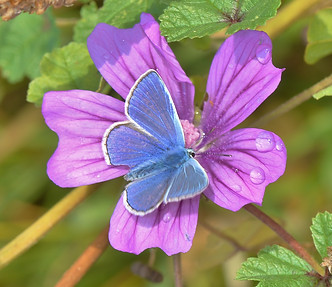
Saturday 17th September 2022 Eastney Beach : The other day (Thursday) I was walking along Eastney beach at the Eastern end when I noticed two Clouded Yellows interacting with each other, obviously sparring males. Today Saturday 17th September at around midday in bright warm sunlight I counted upwards of at least (10) Clouded Yellows, including a female (helice) this number is the best count I've ever had at this...site. I've seen females in the past laying eggs on the beach on the clover where they can find it. Today I think there may have been a mass emergence as most of the ones I saw were all pristine. The winds are coming from the north so any continental ones wouldn't be on the jet stream I wouldn't have thought. Sadly I haven't seen any Small Coppers here this year which is the first time, but there are still Common Blues still to be seen.
%20(2).jpg)
.jpg)
.jpg)
16th September 2022 Old Winchester Hill NNR : One of my last trips to this site in 2022, in reasonable conditions, cool wind blowing from the north and all the butterflies were at the bottom of the fort slope hiding in the area where there is good shelter from the wind. When the sun shone it was rather pleasant, and the species likewise were in reasonable numbers. There were still Chalkhill Blues and Silver Spotted Skippers flying around, but mostly Adonis Blues male and female and a decent scattering of Small Copper. Small Heaths seem to have disappeared. There were no Clouded Yellows, although I did see two on Eastney Beach yesterday having a dogfight, which was a delight to see.
.jpg)
.jpg)
.jpg)
Monday 12th September 2022 Oxenbourne Down: Oxenbourne Down today and the Autumnal feel was hanging in the air, with many leaves starting to turn gold or rustic red. The butterfly count was woeful, with just Adonis Blues , Small Heaths, Meadow Brown, and Whites, being the only sightings. I was expecting a odd Clouded Yellow or at least a few Small Coppers, but I was disappointed.
%20(2).jpg)
.jpg)
.jpg)
.jpg)
Saturday 10th September 2022 Portsdown Hill Field Trip : Another rearranged field trip and the last one of 2022, and we didn't find any of our target species, with the weather the way it's been over the last week or so it's hardly surprising. But the weather did behave itself with no rain, but was overcast most of the time. We did see some sun and the species seen were Chalkhill Blue Common Blue, Small Copper, Red Admiral, Large and Small White, and the Meadow Brown, we also saw Kestrel, Buzzard, and Red Kite. I also saw a Feathered Thorn Moth in my front garden when I got home which was a nice surprise. It was nice to all get together at the end at the pub, and many thanks for some great moments this season everybody, and hope to see you all in 2023..
The Swallows, Wheatear, and Starlings were taken on the Hants/Sussex border at a place called Thorney Island on Thursday 8th September 2022 .......
RIP Your Majesty
.jpg)
.jpg)

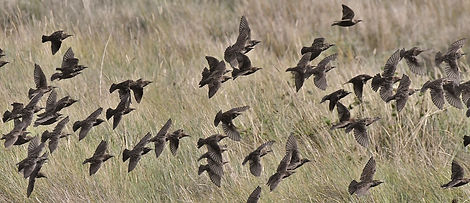.jpg)
.jpg)

.jpg)
Wednesday 7th September 2022 Hayling Island : Another cancelled field trip to Portsdown Hill, but what do you do when the weather is a bit on the wet side, well you go bird watching, and I decided to go to Hayling Island as I had an appointment over there so to kill two birds with one stone so to speak. At one site I saw a couple of Cattle Egrets, which was a bird I've never come across in the UK. At one of the tidal reserves where the tide was well out, I saw plenty of Little Ringed Plovers, and Common Sandpipers. Curlews were also seen and White Egrets fishing in the shallows.
.jpg)
.jpg)
.jpg)

Sunday 4th September 2022 Old Winchester Hill : Today should have been the penultimate field trip, however I made a judgment based on the weather forecast and as usual it wasn't as bad as it was meant to be. I was in the area so I went there anyway just in case anybody turned up but there wasn't anybody so rather than waste the trip I took myself down to the bottom of the car park slope and in heavy leaden clouds, and lots of breeze at times I saw many species of butterfly including fresh Adonis Blues including females, fresh Small Copper, lots of Common Blues and the Chalkhill Blue was just hanging on. The Silver-Spotted Skipper was still in evidence as well, despite little or no warm sunshine, although it certainly wasn't cold. The sun did appear at about 12:00 and was out most of the time I was preparing to leave, and was certainly out all the way home.
.jpg)
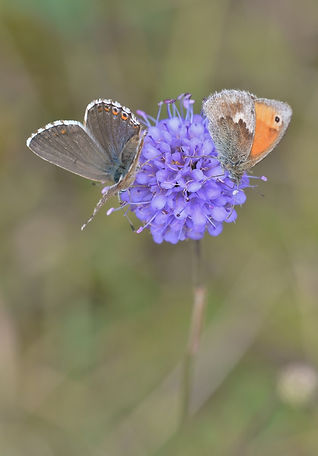.jpg)
.jpg)
Thursday 1st September 2022 Old Winchester Hill : A private walkround today in the afternoon which turned out to be very rewarding. The sun came out in fits and starts however it was warm enough for our quarry the Adonis Blue and Silver Spotted Skipper which we saw a lot of. However there is cattle and sheep grazing on parts of the down where I like to do my counts so the numbers are woefully down on most years because of the electric fencing. There were enough butterflies and other things of interest to keep us satisfied. Orchids known as Autumn Ladies tresses were seen on the shorter turfed areas, and there were a lot of Swallows amassing in the coombe flying and catching the last of the flies before heading back to warmer climes. (12) species of butterfly were seen today which is quite a low number for a major chalk downland but the weather has a big part to play in this.
.jpg)

.jpg)
Wednesday 31st August 2022 Beacon Hill Exton Field Trip: With the Field Trip programme now drawing to a close the species on the downs were very few and far between on Beacon Hill NNR near Exton today. Perfect weather although there was a stiff breeze in the open areas, so it was imperative to get in shelter if that was possible. The wild flowers were also very sparse, the best counts today were the lovely Brown Argus, seen in amongst the footpaths dotted around the fort on the Eastern side. One Silver Spotted Skipper was seen and she was fortunately seen laying her eggs on Sheeps Fescue. It would seem that the species still hasn't really re-established itself over from Old Winchester Hill, and some hard sheep and cattle bashing of the grasses still looks the best option. Other species seen were Comma, Speckled Wood, Red Admiral, Common Blue, battered Chalkhill Blues, and the odd Meadow Brown. No Clouded Yellows or Adonis Blues were seen but that's not to say they were not there. Good views of Kestrels hovering on the breeze and Red Kites were patrolling and rising on the thermals, we also had a Hare bolt for cover on the chalk escarpment, when some of us braved the slope to get to the bottom! It will be interesting how many species will cope next year if the weather is the same as this year. I'd like to thank all who came today.
.jpg)
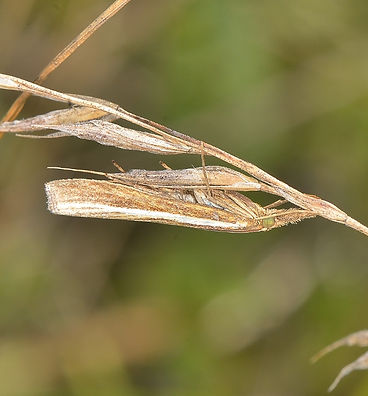.jpg)
Tuesday 30th August 2022 Southsea Eastney Beach and Fort Cumberland: A look around my local patch were in the past there has been good counts of Small Copper and Clouded Yellow has frequented the beach, however there wasn't a sign today as there is very little wild flowers to be seen. However it was better at Fort Cumberland just around the corner, although not much better, with the odd Small Copper and Common Blue. The Clouded Yellow was taken in happier times when the wildflowers were abundant on the beach and the Clouded Yellows were quite common.
.jpg)

.jpg)
.jpg)
In the News
In the News this week was a lovely Deaths Head Hawk caterpillar taken at Northenay on Hayling Island by Ian Lynn. Also a another second generation White Admiral has been seen at North Baddesley by Carol Thorpe. The 2nd generation Duke of Burgundy has been spotted on the slopes of Ivanhoe Beacon a National Trust site in the Chilterns in Buckinghamshire. Normally the 2nd generation are normally restricted to Hampshire in the warm chalk and flint 'pits' of Noar Hill, but there hasn't been any reports from there as yet! There are large numbers of Large Whites ,Clouded Yellows ,Painted Ladies and Hummingbird Hawk Moths being seen as well, we could if the weather stays like this for few more weeks see a second generation Purple Emperor, they are being seen in Germany ....so watch this space!



Saturday 27th August 2022 Back Garden Southsea....The Buddleia is still producing flowers in may back garden and consequently attracting a lot of insects. Yesterday I had two Hummingbird Hawkmoths buzzing around flitting from flower to flower, and today I've counted three, what a triumph! Fascinating to watch them and it's one of those insects you never tire of seeing. One of the moths was obviously in need of some rest and came to perch on my 'Arbour' and it blended into the wood colour of the 'Arbour' perfectly. It stayed there for a good 15 minutes until it was off again feeding on the purple flowers of my buddleia
.jpg)
.jpg)
.jpg)
%20(2).jpg)
Friday 26th August Oxenbourne Down and Garden at home......A look around Oxenbourne Down revealed the Silver-Spotted Skipper seemed to be on the wane with just 7 seen on the wing. However the Adonis Blue seems to have become another species to count here with up to 6 males being seen although no females have been noted as yet. One male was seen dying its wings, so the males are still emerging here. Other species seen were Common Blue and Chalkhill Blue, along with Small Heath but not a lot else. A rather splendid Bordered Straw Moth was noted feeding on the Marjoram, this moth is an infrequent visitor to our shores, and I certainly hadn’t seen one before, and it has a rather ‘racy’ underwing, rather like Victorian knickerbockers! When I got home my Buddleia was busy hosting several Red Admirals, Painted Ladies and two Hummingbird Hawkmoths, along with lots of Large Whites and many Honey Bees.
.jpg)
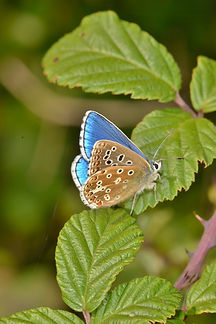.jpg)
.jpg)
.jpg)
.jpg)
.jpg)
Wednesday 13th August 2022 Butser Hill Field Trip : Another field trip and the weather was all gloomy with solid cloud overhead and was quite cool to start with. However as we made our way down to the bottom of Butser Hill the sun started to break through and the clouds started to disperse, and in the brown vegetation the butterflies were very active making hay whilst the sun shone. We had encountered a flock what looked like Willow Warblers on the way down and these were flitting through the Elderberry bushes, and once we had got to the bottom the Meadow Brown and Common Blue counts went through the roof. Most of the wild flowers had died off due to lack of rain, but they were finding Marjoram and Oxford Ragwort as foodplants. The Adonis Blue were in good numbers about 20 odd were seen most of these were males, this is a species I had noted here in the early 2000's and now it seems to have established itself. Also noted were a few Silver-Spotted Skippers on the short turf behind the shrubbery area, another species I had noted here in the 1990's but I think it hasn't been noted here that often as the terrain to get to it is quite tough, still I glad to see it was still here. Clouded Yellows also gave us the run around with about four being noted. With the weather came Kestrels hunting on the top of the hillside about 4 hovering over the top of the downs also Buzzards were screaming as well from the young Beech and dying Ash trees at Grandfather's Bottom. Other species of note were a Orange Swift Moth, Silver-Y Moths, Brown Argus, Small Heath and the Chalkhill Blue were just hanging on.
It took a lot of effort to get back up to the top but we all made it and I like to thank all who came and made this one of the most interesting walks I've completed in 2022.
.jpg)
.jpg)


.jpg)
.jpg)
Saturday 20th August 2022 Broughton Down Field Trip: A Change of day again because of the weather, but it did pay off as we had a lot of sunshine although it was a bit breezier today. However the Silver Spotted Skippers were a triumph, and a few Adonis Blues were dotted about which was rather pleasing. The Chalkhill Blue on site is now fading fast, and the butterfly count was quite low, due to the fact I think everything is desperate for rain and having a hard time at the moment. There was plenty of bird life to see Buzzards, Red Kites and Kestrels were seen over the far side of the down. We didn't manage to see the Brown Hairstreak, I think the wind probably kept any sightings down. I had to leave early and those who stayed on saw Clouded Yellows in another meadow. I'd like to thank all who endured the walk up and down to get to this site, I'd forgotten how arduous it was after a few absent years!
.jpg)
.jpg)
.jpg)
.jpg)
.jpg)

Long-tailed Blue in my Isle of Wight Garden.. At Freshwater today this female Long-tailed Blue on established Everlasting Sweet pea in my garden. The last female LTB recorded on same plant was on the 23rd August 2019. [Posted by Peter Hunt]



Thursday 18th August Shipton Bellinger Field Trip : A field trip which had to be hastily rearranged due to thundery downpours and showers which due to hit the area on Wednesday 17th August. It would seem I made the right call as there was evidence of a lot of water yesterday running down the chalky paths on the site today. In the morning it was very cool and overcast with a veil of mist suppressing any chance of any sunshine, and consequently we were rewarded with very few butterflies or any flora and fauna of interest. After our lunch we were very fortunate to be in the right area as we had a very sunny window of about 2 hours and we began to see the meadow and the hedgerows start to come alive. In the meadow there were Small Heaths, Common Blues, Meadow Browns and in the hedgerows we saw Speckled Wood, Holly Blue, Gatekeepers, Brimstone, and our quarry the Brown Hairstreak. We managed to see at least half-a-dozen or more all females, some being very close to us as we all looked and photographed away, and several were seen in the trees and shrubs in the rides. Fortunately my experience on Portsdown Hill paid off as I used to do transect there. The Wall Brown always used the chalky footpaths and as we walked down several chalky footpaths, we were all rewarded with at least ( Wall Browns many being in good condition, it's always a delight to see this species as it plays with your patience, settling just in front of you and flying off just as you are posed to click the shutter! All in all not a bad half a day, as we saw our target species, although the Magpie moth was absent this time. I'd like to thank all who joined me to make this a most pleasant walk around Shipton Bellinger.
.jpg)
.jpg)
.jpg)
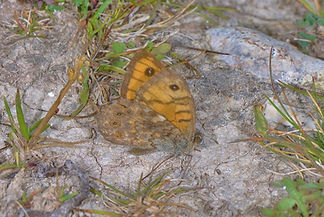.jpg)
.jpg)
.jpg)
Monday 15th August Old Winchester Hill NNR : Visited Old Winchester Hill today to do a count of Silver Spotted Skipper and Adonis Blue, and looked at the western side of the Fort slope. It's very crunchy underfoot due to the drought, but despite this there are plenty of wildflowers surviving on the slopes just showing how resilient they can be! Also there were plenty of butterflies on the wing, and in an hour I counted (15 male and one female Adonis Blues) all of which were in immaculate condition. The Silver Spotted Skipper was also on the wing and these are very hard to count. I had a conservative count of (34) however I did not go all over the western slope, only counting half way up, so this count is probably only about half the total, but I suspect there were many more flying around. I saw several females laying eggs, but due to the low number of rabbits ( lack of burrows noted) on this particular part of the site, there are no obvious patches of bare earth and scrapes for the butterfly to lay on sheep's fescue. Only where the sheep tend to walk when they are moving about the site is there bare earth, this is where I actually noted most of the flying and interaction of the males and females today. But these females were obviously finding the sheep's fescue despite this. Other butterflies of note were Common Blue, Small Heath but very little else, certainly no Clouded Yellows, which I normally see on the car-park slope of Old Winchester Hill.
In Pamber Forest in North Hampshire Peter Eeles has seen and photographed a second generation White Admiral . A very rare occurrence which has obviously happened because of the warm temperatures we have had over the past months....
.jpg)
.jpg)
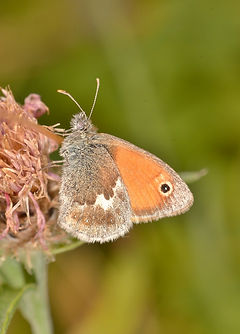.jpg)
Sunday 14th August 2022 Field Trip Noar Hill NNR Another day of melting temperatures, and keeping in the shade was the order of the day. We managed most of the time but we were all suffering somewhat after a few hours and despite not seeing a great deal, we decided to call it a day after about two hours of slow shoe shuffling around a bit of the site. As we started to leave the site I decided to look in the same department where I saw a female Brown Hairstreak last week, and low and behold there was another female in almost the same spot! She wasn't as immaculate as last weeks but this weather must be taking its toll. They must fly up to the tree where males have been seen lekking and get their mating done, and then descend to the ground and wait for me to come along! She brightened up our day, and she opened her wings for us as well. She firstly sheltered under some Dogwood leaves, and then she came out into the open, displaying her upper wings, and then she flew off. There were several others seen as well one in this area, one around an Ash tree, and one over an Apple tree. Other butterflies seen today were several Clouded Yellows, Small Heaths, Common Blues, Meadow Browns and Gatekeepers, Red Admiral, and plenty of Speckled Woods, of which a pair were seen mating on an Apple tree.There were several moths of note one being a Hummingbird Hawk Moth seen at the entrance of the site
I must thank those who braved the weather and hope to see you all soon.
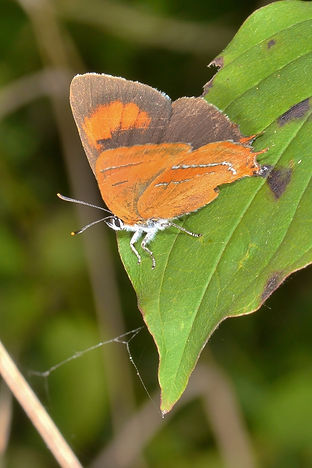.jpg)
.jpg)
.jpg)

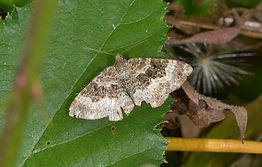.jpg)
Wednesday 10th August 2022 Selborne Common and Noar Hill NNR : I visited today a site I know a lot of people do not visit, one because it is a bit of a hike from the car-park in Selborne, but from Noar Hill it really is a lot easier. Selborne Hill is a large woodland owned by the National trust. There is a lot of mature Oak and Beech trees with a few mature Ash trees which at the moment seem to be ok from Ash dieback. In the height of summer would produce some good sightings of the major butterflies like Purple Emperor and White Admiral and Silver-Washed Fritillary. I saw one Silver-Washed Fritillary today feeding on some very ripe Bramble berries. There's a lot of Blackthorn in the field margins, and on Selborne Common there is also good amounts as well along with Cowslip in the Spring. I didn't see the Brown Hairstreak here today but I know it is recorded here, so is the Duke of Burgundy in the spring. Worth bearing in mind if you want a change from Noar Hill anytime. On Noar Hill today in blazing hot sunshine I kept my head in the Hazel cover when ever I could, seeing Common Blue, Small Heath, Brown Argus, Clouded Yellow, Whites, a couple of Small Skippers, and my quarry turned up just as I was leaving the site, a lovely female Brown Hairstreak. She was a hot butterfly, as she was sheltering underneath Hazel leaves when she settled down. She was a beaut, probably only a day old. I dont hear of many sightings of this butterfly here of late, but its still here, and I suspect she had just mated, and was going off to lay eggs on many 'new' areas of fresh Blackthorn which I had seen earlier. Good Luck girl!
Must say Hi to Peter who I met at Noar Hill thanks for the strawberries mate they were lovely. Hope to see you again in the field some time....!
.jpg)
.jpg)
.jpg)
.jpg)
Monday 8th August Fort Widley Portsdown Hill: Looked around Fort Widley in very warm sunshine today to see if I could espy the Brown Hairstreak, however I was out of luck today, and I also remembered the area I walked was also good for the Wall Brown several decades ago so if the Wall is making come back it would be most welcome on my old transect route thankyou! The area is full of Blackthorn thickets and good meadows full of wildflowers all be it all dying off due to the drought. Common Blue was seen and Brown Argus, Meadow Brown and Gatekeeper, Whites, Holly Blues, Commas and Red Admiral, but nothing to get the heart rate racing. Back in my garden I was visited by a lovely Jersey Tiger Moth feasting on the last of the Buddleia flowers. On my front door I believe was a Small Dusty wave moth
.jpg)
.jpg)
.jpg)
.jpg)
.jpg)
.jpg)
.jpg)
.jpg)
.jpg)
Friday 5th August 2022 Oxenbourne Down : A short trip up to one my local chalk downland patches and the butterflies didn't disappoint. Up to 35 Silver-Spotted Skippers were seen whizzing about and feeding up, laying eggs and also mating. The Chalkhill Blue was also in enormous numbers, but everything looks very dry and barren in places. I looked in on some of 'my' Cowslip patches and they have shriveled up to almost nothing, I just hope this isn't detrimental to the Duke of Burgundy colonies on site, next year should could prove very interesting in regards to numbers. We've had dry summers before, and the Duke of Burgundy can survive on the north facing slopes better, due to the fact they are not facing towards the sun. Other species seen were one female Dark Green Fritillary, Gatekeeper, Common Blue, Small Heath, Meadow Brown, Ringlet. No Brimstones were seen and the Vanessids seem to have dived into hibernation really early.
.jpg)
.jpg)
.jpg)
Thursday 4th August 2022 Bedlam Plantation : A visit to a lesser known area on the Hampshire side of the large Army ranges in and around Tidworth close to Shipton Bellinger. The weather was warm but overcast most of the time with very little breeze which to me is perfect conditions for butterfly watching. Arriving just before midday the butterflies were in full swing and the first butterflies seen were two Wall Browns both chasing each other, a territory dispute I suspect, this put me in the mood to find more. There were plenty of Brimstones, Brown Argus, Common Blues, Gatekeepers, Meadow Browns and Small Heaths, also a couple of Silver-Spotted Skippers. The Walls just kept on coming and on the edge of a farmers field where there were sufficient areas of wildflowers, these areas produced up to twenty odd Wall Brown's over a course of a couple of hours. On the way back to the car-park, I espied a female Brown Hairstreak which was fresh as a daisy, and also there were still Wall Browns to be seen and females were also seen being much larger than the males and were easy to Identify, feeding on Thistles. Probably one of the most satisfying 'mini' field trips I've ever done, a big plus for Military sites which are largely untouched by pesticides and other nasties and are full of hedgerows, with blackthorn and birds song plenty of Ravens were heard and Yellowhammers, and Long Tailed Tits, chattering in amongst the hedges.
.jpg)
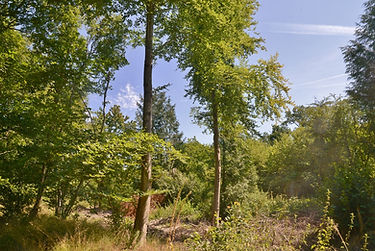.jpg)

.jpg)
.jpg)
Saturday 23rd July 2022 Charlton Down :My last look for the Purple Emperor today , and I was just East of the Queen Elizabeth Country Park complex close to the Hampshire/Sussex border. There were Chalkhill Blues a plenty on Charlton Down, with a sprinkling of Common Blues, and Dark Green Fritillaries were still very evident with several males and females in good condition. Marbled Whites were very low in numbers and ones seen were very tatty. Good numbers of Essex and Small Skippers flying between flowers and dry grasses. In the woodland complex on the border the male Silver-Washed Fritillaries were still frantically trying to mate with the last of the females. Several Dark Green Fritillaries were still patrolling the rides. There wasn't much else one White Admiral, and a female Purple Emperor flying from one side of the ride onto the other at 14:30, in the heat of the day was probably ending a bout of egg-laying. This area has been a good source of Purpleling for me in 2022. Which added to the other encounters in the past seasons makes it the most Eastern of the Purple Empire in Hampshire.
.jpg)
.jpg)
.jpg)
With the heatwave gathering momentum, and we all head for the beach, the shoreline at Portsmouth has become very attracted to Dolphins which have been seen off of the coast within shouting distance of the shoreline. Obviously dont get too close if you happen to see them, if you are on a boat and these lovely creatures do decide to investigate you just enjoy the moment, believe it doesn't happen every day although the occurrences do seem to be becoming more frequent..... Global warming is making our seas more attractive to these creatures.

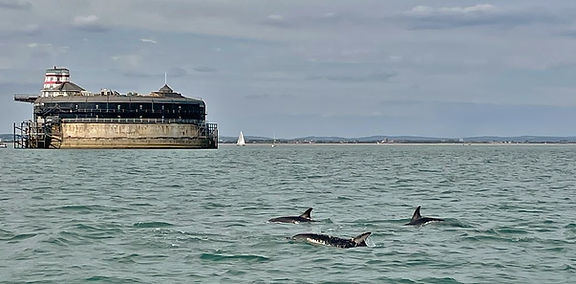
Sunday 17th July 2022 Creech Wood Field Trip : Creech Wood is a lesser known Purple Emperor wood, in the Forest of Bere complex and today we were at the weathers mercy but as it turned out the breeze in some of the rides was quite welcome. We saw a sprinkling of Silver-Washed Fritillaries, and one or two White Admirals, and in the more open rides there are lots of wild flowers particularly meadow and downland flowers several Brown Argus were seen, and in the wayleaves a Chalkhill Blue was spotted. I suspect these have come from nearby Portsdown Hill. Several Holly Blues were also seen along the usual fare in the rides. We didn't see the Purple Emperor in the rides, although there was a possible sighting of a female, but we did see several males at one of the Assembly Points close to the major car-park. These were rather ragged and look as if they may only have a few more days left in this oppressive heat. Many thanks for a splendid turn out in such difficult weather conditions, thank heaven for shade in the rides!
.jpg)
.jpg)
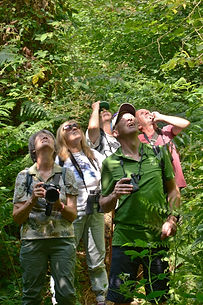.jpg)
Friday 15th July 2022 Straits Inclosure : Today was far too hot to see HIM anyway it's rather past their days where they are advertising their presence in the lofty Oaks and Sallow searching for any unmated female. The star of the show was still the Silver-Washed Fritillary most are looking a bit ragged, but there are still a few looking fit and able and several mating rituals were observed in the ride. White Admiral was also present, most being female and several were seen disappearing into the dense coppice to search for shady Honeysuckle. The trees are looking as if some are needing water, and I noticed that some of the sallow and their leaves are starting to turn upwards and crumple up. Most of the ditches are bone dry ...we desperately need rain.
However at one of the Assembly Points there was a fight between three males and then several minutes later a fight between two males and a lone male just patrolling his vista at a another Assembly Point close by.. In an hour or so in the mid afternoon it was really too hot for too much action, but it was good to see HIM was still present.
.jpg)
.jpeg)
Photo: Female Purple Emperor Bryn Jones
.jpg)
.jpg)
.jpg)
Wednesday 13th July 2022 West Harting Down Field Trip :This field trip which hugs the Hampshire/Sussex border is really a walker's paradise with small stops along the way. In the warmth of the day it was a real test on everyone's will to get to the summit and look at the fabulous views of Queen Elizabeth Country Park and the Isle of Wight. Along the way there were small interactions with brief glimpses of the male Purple Emperor on the flatter areas of the woodland, flying around Beech trees and Oak and there is huge amounts of Sallow, in all we had around ten observations with two males on the ground, one very briefly at the summit, when we were having our lunch, a big diversion when you eating your sandwiches, and he had the nerve to come back for a second pass. Also we had a lovely encounter with a Empress which flew around us giving us a great fly past. On the way back two of us split from the main group and they encountered another female purple emperor on the ground and he stayed for up to 10 minutes. Both of these male and females were in very good condition considering they are now reaching their peak time and I wasn't really expecting them to be grounded now. Also there were good moments with Silver-Washed Fritillaries, and Dark Green Fritillaries in the main part of the wood, and a few encounters with White Admirals. On the Buddleia bushes there were lots of Commas and on the ride floor and a single Hummingbird Hawk moth and a Scarlett Tiger Moth put in an appearance.
A great Field Trip definitely the best of the year and many thanks to everyone who braved the heat of the day.
.jpg)
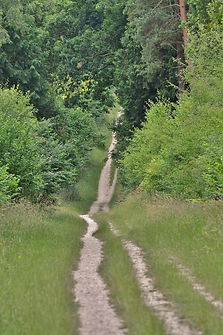.jpg)
.jpg)
.jpg)
Tuesday 11th July 2022 West Wood : A Short lull in the heat wave today was slightly more comfortable for me and the Purple Emperor, as I did a quick look into West Wood close to Winchester. The weather was overcast and slightly breezy and was cooler, and this payed off in a walk around several of the rides from about 12:00. The first encounter was a lovely female in a ride which dominated by conifer trees, but there is a sprinkling of sallows in the ride and this was my closest encounter with an Empress in 2022 so far. I think she may have been egg-laying and was just a few feet away flying around the ride and then disappeared over the ride into the shrubbery. Shortly afterwards there was a male seen in the vicinity probably checking out the status of the female, as they do mate more than once. In Ashley's ride there were sightings, again in and around the very tall conifers. In the main ride there were no males imbibing on the dead tree, but there were several encounters with a male chasing a female, and a chase with two males in the main ride. I saw several males just ambling around oaks and beech trees not doing very much at all. In all we stayed about and hour and a half in the main ride and we saw at least 20 odd sightings. Other good numbers were very fresh Brimstones, and good numbers of Commas. On Pitt Down there was a family of Jays all on the ground which I had never seen before, all in all a good couple of hours of Emperoring.
.jpg)

.jpg)
.jpg)
.jpg)
Sunday 10th July Pamber Forest Field Trip : A field trip around one of Hampshires 'lesser' known woods Pamber Forest, however it is packed with flora and fauna interest, although today we all melted, as it was the hottest day of the year. Unfortunately we didn't find our quarry the Purple Emperor which is hardly surprising as it was so warm. We did see a few Silver-Washed Fritillaries and White Admirals, and on the heathland there was very little flying, Silver-Studded Blues put in a token presence, Small Skipper , Gatekeeper, and Meadow Brown, plus several Brown Silver-Line Moths, and a Wolf Spider in its funnel web kept a lot of us observing it in its burrow. Stonechats were busy on the heathland there was very little evidence of the Grayling butterfly yet.
Footnote: Pamber Forest used to be one of my regular butterfly visits when I used to live in Reading as it was one of nearest Purple Emperor woods. However it hasn't the recognition as a Iris site, due to the lack of records, and is not helped by the lack of good sallow stands although yesterday on the field trip I did find some reasonable sallow trees 'caprea' ie goat willow. We also met a person in the wood who had taken a male Purple Emperor on the ground a few days before, and it had also been seen at the beginning of July as well. It lacks records because nobody really goes looking for it there. I suspect it is there in reasonable numbers especially this year, but the Oaks are very tall in the wood, and go largely unnoticed because of this. Females probably use outside of the wood sallows in the field margins , due to the lack of 'caprea' in the wood.

Phillip Nangle from Farnham rescued this beauty from his friends car, and he had it on his hand and on a log for many minutes. This is a very confused fresh male, and the beauty of this is plain to see. Also he took these photographs with a mobile phone!

There has been good sightings again in the week ending 08th July of the Purple Emperor with several records coming from Micheldever Woods, and Creech Wood in the Forest Bere. Today we had a report from Hedge End at Wildern Local Nature Reserve, a female which was sitting in a Weeping Willow tree. I have never had any records from here so that's a good record. Most of the males now are getting quite tatty although the odd few are in good condition and are still coming to the forest floor.

.jpg)
.jpg)
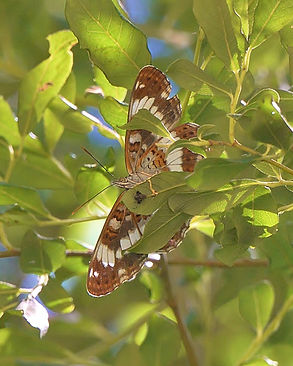
Alice Holt Forest 8th July 2022 : The hottest day of the year and the Purple Emperor in Alice Holt was very much restricted in movement, and just shading himself from the heat most of the time. I did manage to see a couple of males flying in and around some Oaks but they were not doing their normally searching the sallows and oak edging as normal. A couple of females were encountered, and these were obviously egg laying as they were only glimpsed for a few seconds. I had started to melt time I got back to my car for some lunch, and had planned a few hours at an Assembly Point. However it was far too hot, I saw a female fly over the main arena and went into a large oak tree. I dont know what she was up to but I feel she knew there were a couple of males about, as about an hour later I saw three Purple Emperors flying together, quite low down in the shrubbery, and then one of them split away, and this left one following the other, which is normal behaviour for the 'follow me' flight when the female leads the way for the male to follow her and they mate in a lofty oak for hours.. I also had a good sighting of a female White Admiral egg-laying in the traingle at Abbotts Wood Inclosure (see picture)
.jpg)
.jpg)
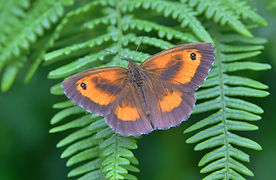
.jpg)
Whiteley Pastures Field Trip 06th July 2022 I was quite surprised today to see how well Whiteley Pastures and Botley Wood look with the amount of mature Oaks and Sallow content underneath the oaks, and the growth of these trees in and around the urbanisation of the Hampshire landscape here, where there are thousands of houses being built and a large shopping complex right on the woodlands doorstep. We walked up the main ride slowly and my whistle became rather busy as ''looking up not down'' we were frequented with males oak edging and sallow searching all the way along the ride. They came down to a reasonable height for most of the field trippers to get their 'eye in' as it were, as these magnificent beasts went about their business. In all we must have seen the Emperor about 15 or so times, but how many of these we saw two or three times is hard to guesstimate, but I suspect we saw about 6-7 individuals. Along with the Emperor we saw a few Silver-Washed Fritillaries, but the numbers seemed to be poor compared with other woods this year, and there was a sprinkling of White Admiral, along with the commoner species along the ride. We even looked at the famous Elm tree and it looks to be in good shape still but it is hard to see it from the ride for any sightings of the White-Letter Hairstreak. When I first visited this site in about 1985, I could walk past the Elm in a meadow seeing Marbled Whites etc, now it's a Sallow and Hazel jungle totally impenetrable.
I was glad to see a good many 'new' faces today, on the field trip and hope they all went home happy.
Footnote: Whilst having a coffee in Marks and Spencers looking out of the window along a skyline of mature oaks I could make out a male Purple Emperor doing his Oak edging, there aren't many places you can watch Emperors in such comfort!
There have been some great sightings in the last few days with two Purple Emperors on a car bonnet in the car-park at Micheldever Wood, and also a fresh male was seen today 6th July also in Bells Copse part of Havant Thicket four males and female were seen. There has been also good sightings in West Wood, and Alice Holt Forest as well. Whiteley Pastures has certainly come of age, considering the housing being built around it the Emperor certainly has an Empire there!
.jpg)
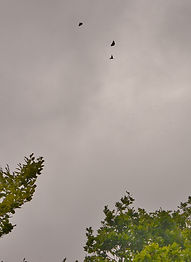.jpg)
.jpg)
Abbotts Wood Inclosure 4th July 2022 : Back at Alice today where the weather was still unfavourable, only in small bouts of sun did the Emperor fly . It was seen on no less than 20 odd occasions, Oak edging and sallow searching and also I saw one searching an Ash tree (see pics) Also a female was noted engaged in egg-lying in a sallow in one of the rides. At an Assembly Point I found it was too breezy majority of the time for a lot of activity but when it was favourable I counted three males in a vista and these would engage in a chase for many minutes until they split up and then went back to their perches on a Beech tree. The Males are now starting to look rather jaded in Alice, as this site they are quite active, although I suspect there are still a few still looking a bit more as they would in their first week. Females should be in good condition, although a heavy bout of egg-laying and they soon look a little forlorn.
Congrats to Mark Tutton for the great count at Whiteley Pastures today where he counted (16) individual Male Purple Emperors, this must be a sort of record as I've been visiting this site over the past 40 odd years and got nowhere near this number.
.jpg)
.jpg)
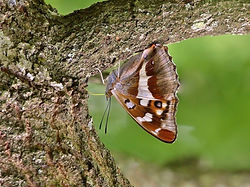.jpg)
.jpg)
Sunday 3rd July West Wood Crab Wood Pitt Down Field Trip: It's not often I squeeze three sites into one field trip, well today was just one of those days, despite the weather not being good Purple Emperor weather, we all had good views of HIM flying around many of the Oaks and some Conifers, in West Wood. Also one was seen flying out of Crab Wood, and there were closer views of a male and a Red Admiral imbibing on tree sap on a dead Oak tree in the main ride. We also had a very short viewing of a male imbibing on the ground but there was a lot of activity around the male which spooked him and he never came back, which was a great shame, as a lot of the field trippers would have been in awe of the beauty of seeing this wonderful insect close up for the first time. I had baited some of the rides, and the flies soon got stuck in as it really did smell, but the weather was a little reluctant to be sunny all the time, so consequently the males were a reluctant to fly a lot of the time. However I think we saw the males about 15 times, and consequently we probably saw 6 or 7 males, plus one in Crab Wood. There were good views of Scarlett Tiger Moths, along White Admiral and Silver-Washed Fritillaries. In the Afternoon it was all about the Dark Green Fritillary, which on the western side of the down was literally covered in these beautiful insects, in fact I dont think Ive seen so many, a good 50 plus males and several females. I like to thank all who came and made this a special field trip.
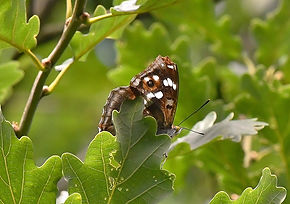.jpg)
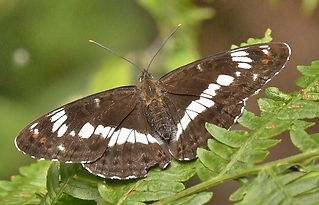.jpg)
.jpg)
Abbotts Wood Inclosure 1st July 2022 : Over the past two days I have been studying the male Purple Emperor in Abbotts Wood Inclosure whilst dodging some hefty showers. Yesterday was a complete wash out only having seen a male twice and that was just re-adjusting himself on a sprig of an Oak. Today was a lot better with no showers and lots of heavy leaden skies but less wind and more sunshine, especially towards mid-afternoon. It would seem this year the males are occupying different Oaks in the woods to shelter themselves from the almighty gusts of wind that seem to hammer them at times. The males were active in small bouts of warm sunshine, and again when the sun went behind hefty areas of cloud, they still came out and engaged in combat chasing each other over the ride into sallow thickets, and then reappearing a bit further down the ride to complete a circuit of sallow searching and Oak edging. Several males were seen quite content just sitting on Oak sprigs minding their own business, only moving when something irritated them, and they were using the Oaks in the ride like an Assembly point in the afternoon. In all I saw the Purple Emperor about 20 odd times over a period the 11:00 and 13:00. This probably equates to about 8 or 9 individual males, but I didn't see any female activity, as I dont think there are many around yet. I was only looking at an area of about 100 yards of ride space, so any other activity went unnoticed.
.jpg)
Alice Holt Forest from Oakhanger
Over the last two or three days the Purple Emperor sightings have gone up as the species start to emerge in significant numbers, they have been seen in Bentley Wood, I know its Wiltshire but there are many woods around that area attached to the site that have the Emperor which are in Hampshire. Also it has been seen on Yateley Common in the Northern part of Hampshire, and Matt Parkes found one in a greenhouse at Old Alresford (see Photos below). We are due a week or so of good weather so I'd expect the sightings to go up further. I appreciate that now it is difficult to justify going about and about whilst Petrol prices are sky high.
.jpg)
.jpg)
.jpg)
Tuesday 28th June Alice Holt Forest : Despite being mostly a windy affair at Alice Holt Forest today, and clouds just kept on coming in and in the three to four hours on site turned out to be most rewarding. It didn't look very promising at first having arrived at 10:00, and a walk around one of the rides produced many White Admirals, I have to say this is one of the best years I've noted these splendid insects. I have to go back to the heady days of the mid-1980's in Pamber Forest or one of the New Forest Inclosures to get the numbers I've seen in two visits over the last week. Also the Silver-Washed Fritillary seems to be doing well as well. However my quarry seemed to be absent the mighty Purple Emperor as it was just too windy in the lofty tree tops. However it did start to break up and the sun shone for ten to twenty minutes at a time on occasions, and this goeded the beast into action. At 11:40 a male was seen Oak edging at the very end of the main track (south) Again at 11:42 One male was seen heading north, it was probably a second individual as the other noted had gone over the ride. At 12:00 one male was seen Sallow searching at the triangle and another Oak edging and Sallow searching, this is the behaviour to look for when out and about in the woods.It was very gusty at times and I was only seeing his majesty at intervals of about every twenty minutes or so.I noted males at 12:24 and again at 12:50. The male at 12:50 had settled on a Hazel branch and Mark Tutton had whistled me over , good job I heard it as I was just departing! He stayed splendidly proud on this Hazel leaf for a good 15 minutes, in a good bout of warmish weather. He was about 8-10 feet from my head, and I had brought my 200-500mm lens which came in rather useful! At 13:10 he alighted from the Hazel leaf and alighted to the floor of the ride, doing figure of eights and then settled down imbibing on salty minerals on the ground. He was a bit skittish to start with, but as he went up the ride Mark and I followed him and he settled down wing waving after about 10 minutes or so. A great morning as it turned out, and I heard that there was several more males seen along other rides today as well.
.jpg)
.jpg)
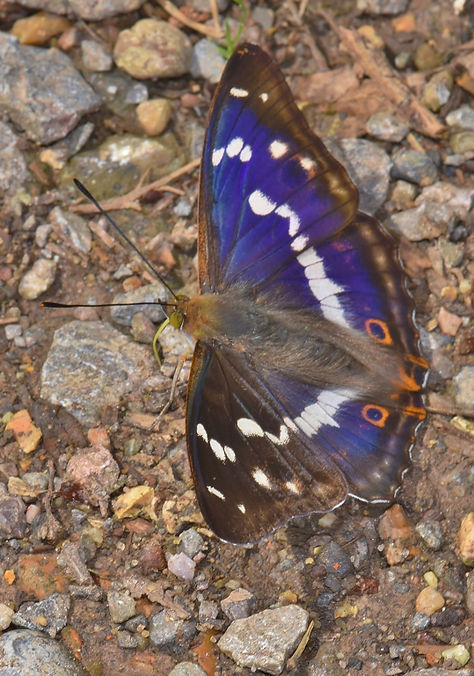.jpg)
.jpg)
Sunday 26th June 2022 Broxhead Common Field Trip Moving on from Straits Inclosure it was the field trip in the afternoon to see the Silver-Studded Blue. There were many about once we found a spot out of the windy conditions, and the males mostly were in good or even pristine condition. There were several females seen as well and these after a time seem to be mated, and we ended up with several mating pairs quite close to each other. There wasn't a lot else though, with Ringlet, Meadow Brown, Small Heath, Small white, Red Admiral, Comma but there didn't seem to be any moths about which was disappointing. A short field trip to a very interesting site, and a very important site nethertheless. Thank you everybody who came.
Sunday 26th June 2022 Straits Inclosure : My first venture out to see the Purple Emperor in 2022 after a successful trip down to Devon to see the High Brown Fritillary . Unfortunately it was very windy and his majesty doesn't like wind. However he briefly took off from one of the magnificent Oaks at 10:50 close to the dip in the track near the first deer tower, but quickly regained his composure as the wind was just too much for flying, and there he seemed to stay. I must say the Silver-Washed Fritillary is looking splendid this year as are the White Admirals, it looks like a good year for both species. Mark Tutton managed to bag an Emperor on some doggy-doo but not a lot else was seen other than the usual butterflies in the rides like Ringlets, Large Skippers, Meadow Browns and Marbled Whites.
.jpg)
.jpg)
.jpg)
.jpg)
.jpg)
.jpg)
.jpg)
.jpg)
.jpg)
.jpg)
Into the heart of Devon
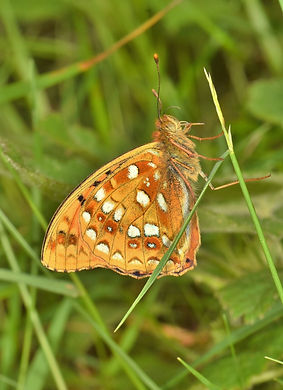.jpg)
Aish Tor Devon Sunday 19th - 24th June 2022
You could be forgiven for thinking that I’ve been buried in some deep Hampshire woodland looking for ‘his majesty’ but nothing could be further from the truth. Over the past week I’ve been in the rolling Devon Countryside looking for one of Britain’s rarest butterflies the High Brown Fritillary. What’s this got to do with Hampshire I hear you ask well nothing at the moment, but in the past it was one of Hampshire’s most common Fritillaries as in well coppiced woodland and open heathland it frequented the New Forest and other woods in the last century. I was lucky enough to see this species in Bentley Woods in the 1980’s in the Eastern Clearing, whether these were natural specimens or not is open to question, but I did see a mating pair, which gave me hope.
Back in Devon though it can be found at several spots. I visited a site known as Aish Tor and I am writing this because many people may be going on holiday down there in the next week or so and would wish to see it, if they can identify the bright orange flash as it flies past. I was advised by many observers there that the best time to see it is at 0730 or earlier on a warm morning, where they sit on top of the ferns to warm up. We did this and it payed off to a degree, but the answer was that they were up a lot earlier than that and were on the wing at 0730! However the site is littered with good areas of Bramble in flower where the butterfly will re-fuel and you can readily identify this beautiful insect. Every now and then there will be a passing Dark Green Fritillary but there are certain identification markings to distinguish the two species. I got the hang of it by the end of the fifth day, however looking at my photos today I realise it is quite tricky trying to identify these two species from the top, the best way is looking from the underneath.
There was also another rarity the Small Pearl Bordered Fritillary just about hanging on there as its flight season was nearly at an end, but again another butterfly which has all but disappeared from Hampshire and it was a triumph to spot this miniature version of the Dark Green Fritillary or High Brown flying past.
All in all it was a great week now I’ve got to knuckle down and get my trousers on my head as its silly season….
.jpg)

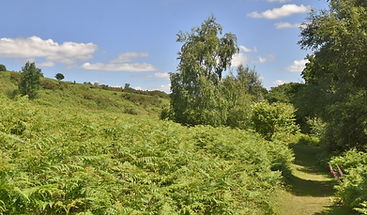.jpg)
.jpg)
.jpg)
Friday 10th June 2022 Oxenbourne Down: Favorable weather today although quite windy on exposed slopes but generally good weather gave me a chance to look at Cowslip leaves and if there were any Duke of Burgundy caterpillars feeding up. Well I didn't see any however it may still be a few weeks too early. However I did see my first Dark Green Fritillaries flying around and they looked magnificent. There wasn't a lot of butterflies around with Small Heath and Common Blue being the most frequent. There were a lot of Pyramidal Orchids and Common Spotted Orchids in profusion on the the downland. This really is the time of the first summer butterfly and moth species emerging. White Letter Hairstreak are out as well as Silver-Studded Blue in Hampshire.
.jpg)
.jpg)
.jpg)
.jpg)
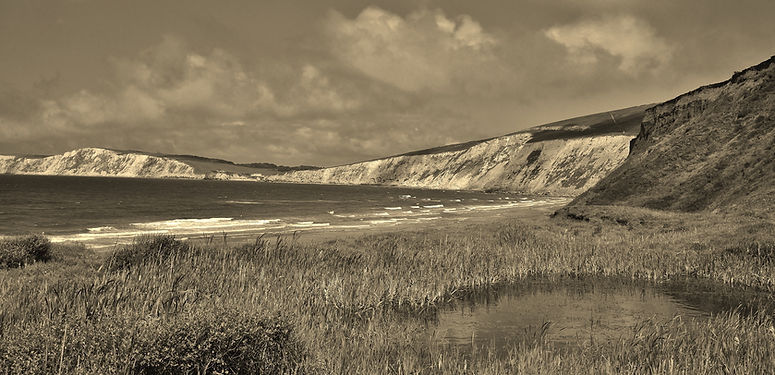
.jpg)
.jpg)
Isle of Wight 5th 6th 7th June 2022 : My latest Pilgrimage to the Isle of Wight was plagued by bad weather the only suitable day was Monday 06th June and even then the species count was quite woeful. The Glanville Fritillary managed to put in an appearance but the numbers were well down compared to this time last year, but several were in good shape, with one or two very fresh males even. However at Afton Down the numbers of Glanville Fritillaries there were very hard to find, and the Adonis Blue were very scarce, with just one male and a very fresh female seen on site. The best counts came from Large Skippers, and Burnet Moths were quite common. Other species seen were Brown Argus, Common and Small Blues a few Dingy Skippers. The Bee Orchids looked a picture and all the other wildflowers were growing in profusion like Birdsfoot Trefoil, Horseshoe, and Kidney Vetch, and thrift.
My thanks go out to Nikki Kownacki for the use of her marvellous garden to take the photos of the Red Squirrel, Bullfinches, and Great Spotted Woodpecker.
.jpg)
.jpg)
.jpg)
.jpg)
Friday 3rd June 2022 Butser Hill NNR : Probably my last venture out looking for my specie the Duke of Burgundy as its almost over especially on the chalk. I found none on Oxenbourne Down today and a quick trip to Butser Hill produced (13) ragged individuals the worse for wear were the females. It was nice to see them still flying into June but they have had to endure some pretty cool nights which kills all but the most robust of the species. Other species seen were Brown Argus, Common Blue, Small Blue, I failed to find the Adonis Blue, however I shall not give up on it as the site certainly looks able to support a colony. Small Heaths were everywhere, and so to were Grizzled and Dingy Skipper, Large Skippers are building in numbers, Brimstone, and what looked like a couple of fresh male Orange Tips! I never espied the Dark Green Fritillary but they must be out soon here. I also saw just one Small Tortoiseshell despite the site a few weeks ago was covered in the caterpillars!
.jpg)
.jpg)
.jpg)
.jpg)
.jpg)
.jpg)
.jpg)
.jpg)
Wednesday 01 June 2022 Bentley Wood Field Trip : Reasonable weather today was really only one decent highlight on this field trip as I failed in finding both of my Target species today. There was very little in Eastern Clearing with very few butterflies and even less wildflowers. What butterflies and moths we did see were nothing special, there were two very rustic looking Pearl-Bordered Fritillaries, the best count came from Speckled Woods, which were in reasonable numbers as we walked around the site and along the tracks to get to another meadow, which again was another disappointment. Other species seen were Grizzled Skipper, Small Heath, Meadow Browns, and an Adonis Blue which was the only real butterfly highlight. This must have alighted from over from Dean Hill, and was in very good condition. Moths were 5 Spotted Burnets, Brown Silver Lines, lots of Burnet companions and Mother Shipton Moths. We looked in on a pond and saw lots of Dragonflies, and Damselflies, and the bird life was quite good with a Cuckoo singing in the distance a lot of the time on site. I would like to thank all who came on this field trip,hope to see you again soon

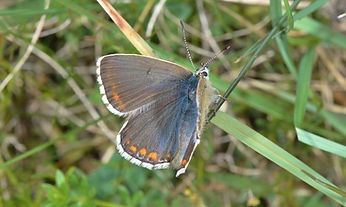

I've been sent this photograph (top left) of a male Adonis Blue sighted on Butser Hill, not only is it a rare find to see them on Butser Hill but it would seem to have two black dots on its forewings. (Photo Copyright Nyree Fearnley) A site very close by would seem to have taken up the mantle for the Adonis Blue as I've noticed over the last two weeks or so there has been several Male Adonis Blues flying about and the other day I noticed a freshly emerged female Adonis Blue. This site has all the attributes for the Adonis Blue butterfly plenty of food plant and very short turf, if its naturally found its way there then hopefully it can establish a flourishing colony.
.jpg)
.jpg)
.jpg)
Friday 27th May 2022 Butser Hill NNR: Today I did impromptu field trip with a couple from Yorkshire, who had requested a site visit to see Duke of Burgundy and other species. I promptly said Butser Hill hoping the Duke of Burgundy was still in reasonable numbers and in some kind of condition they were recognisable.....I needn't have worried, after a wander around a northern slope and along the bottom from Grandaddy's Bottom to the corner where it goes very steep we/I counted upwards of (40+) and most of these were in very good condition, and several were very fresh. In fact the worse one espied was a female which had probably had a long run at laying eggs. Other species seen were Small Heaths, Brown Argus, Common Blues, Brimstone, Small White, lots of Green Hairstreak which again were in very good condition, Speckled Wood,Peacock, Red Admiral, Painted Lady, Small Blue, Grizzled and Dingy Skipper. They went home very happy and I now have good info on butterflies in Yorkshire like Northern Brown Argus, Large Heath, and Scotch Argus.
.jpg)
.jpg)
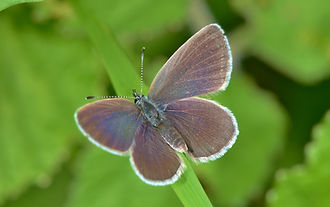.jpg)
26th May 2022 Martin Down Field Trip : A gloomy day with 100% cloud cover most of the morning, which rather surprised me when I drove in to the car-park there were a fair few waiting for the field trip to start! The breeze was quite keen and I didnt hold out much hope of seeing much, but today I think it was quality not quantity. Around the first rifle butts there were Small Copper, Dingy Skipper, Grizzled Skipper, Adonis Blues, Common Blues, Brown Argus, a couple of Marsh Fritillaries, but in the gullies, there were a good number of Small Blues along with the odd Painted Lady and a few Small Heaths. Common Spotted Orchids were also seen as well as the Burnt Tip Orchid but these weren't very big. There was a constant chatter of Skylarks on the downland, and Yellowhammers, Whitethroats, Stonechats, Corn Bunting dotted around the field margins and the calling of a Cuckoo in the distance, unfortunately we didn't hear the Turtle Dove. The Common Carpet Moth was very common along with a few Burnet Companions, along with 5 spot Burnet Moths,Yellow Shell, Cinnabar Moth, Lattice Heath,and Treble Bar Moth. I'd like to thank all who came a braved the cool overcast weather.
.jpg)
.jpg)
.jpg)
.jpg)

Tuesday 24th May Somewhere in the Meon Valley : Heavy showery rain really turned this day into a very sodden affair with very wet undergrowth and cool breeze it wasn't going to be a classic by any means. There weren't many invertebrates around and what I did see weren't in high numbers, there were Small Blue, Speckled Woods, Duke of Burgundy, Common Blue, Small Heath, Painted Lady, Dingy Skipper, and Green Veined White. For a change I didn't see the Brimstone, because of the temperatures I think. The female Dukes were hiding under leaves as the rain came down, and then it was fine blue sky again and the temperature shot up. Lovely female Broad-Bordered Chaser was seen hunting on the wing, and then she stopped for a photo. I almost fell over a Hare, as the grass is growing so tall now I just cannot see them, and I did see a Red Kite at close quarters with something in its talons, and this looked suspiciously like a 'Leveret',these birds are not just scavengers and have been known to take fish from ponds and lakes.
.jpg)
.jpg)
.jpg)
Sunday 22nd May 2022 Stockbridge Down Field Trip : This was one of those field trips where you come back to the car-park and feel that everything has gone to plan...the weather was sublime,excellent attendance, and everybody seemed to be having a good time with the amount of species seen. I counted (19) species of butterfly and moths were very spartan it has to be said, but the 5 and 6 spot Burnet moths are building quite nicely and there were generous amounts of Burnet Companions flying about. This is the first time I have seen the Adonis Blue at this site, which was a treat, and the Small Blue seems to be in good numbers all over the down, and of course the Duke put in an appearance, with several freshly emerged specimens, there were excellent numbers of Green Hairstreak, but alas the Pearl-Bordered Fritillary, is sadly absent. It became rather hot by mid-afternoon, but a good time was had by all, and this will go down as one of the best I have the pleasure of leading, and I must thank all who came from near and afar, you know who you are.
.jpg)
.jpg)
.jpg)
Saturday 21st May 2022 Westbury Park : Westbury Park is relatively unknown site which I have visited for many years now and has now become rather unfit for many species of butterflies, none more so than the Duke of Burgundy. Despite this I still managed to chalk up a count of (7) which is average for most sites in Hampshire. I saw at least (5) individuals in a relatively new area, which is covered in Bramble and of course this rips their wings to shreds and are now looking distinctly tatty. Other butterflies were Painted Ladies which have become quite commonplace at sites I've been visiting, are we in for a bumper Painted Lady Year? Because the terrain is now very overgrown I rarely see very many Dingy or Grizzled Skippers and other species are left wanting as well. The site is full of dead Ash trees and I wonder if these were to be felled then the woodland would be more open for more specialised species. There is a lot of storm damaged trees as well, especially dead Elms and Oak trees.
.jpg)
.jpg)
.jpg)
.jpg)
.jpg)
Thursday 19th May 2022 Magdalen Hill Down and New Forest : The morning of 19th May was spent at Magdalen Hill Down looking at the site, and looking at an area of scrub which may be earmarked for an introduction of the Duke of Burgundy. I was admiring the good numbers of Small Blues and the fantastic landscape all around, with being so close to the New Forest I decided to have a look at the Pearl-Bordered Fritillary as I had to cancel the field trip a few weeks ago, and we went to Pignal Inclosure, and most of the afternoon was counting very good numbers in the rides, with several newly emerged male and females. But the majority of the Pearls were very worn and were constantly feeding on Wood Spurge and Bugle plants. I counted (50) quite easily, and stopped counting at that point but the sum total was nearer a hundred by the time we got back to the Standing Hat car-park.
.jpg)
.jpg)
.jpg)
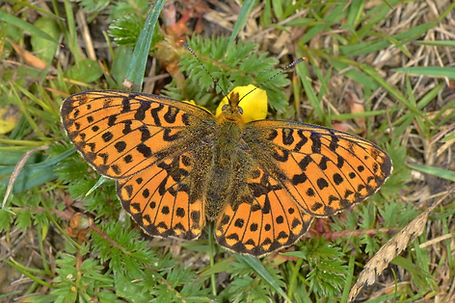.jpg)
.jpg)
.jpg)
Wednesday 18th May West Wood and Pitt Down Field Trips : Another very eventful day in good weather, although it looked a little dodgy to start with however we ploughed on and the sun shone for most of the time and the temperature was quite warm. At West Wood a few days on from my last visit and the Duke count was up to about (25) with males and females still emerging there. We saw a female flying into a Primrose plant and really testing the suitability of the leaves with her abdomen and feet. She hadn't been mated I dont think, however she was doing the round of several potential egg laying plants. Dingy and Grizzled Skippers in the coppiced woodland areas and Holly Blue flying in the main ride, where there is good flora with lots of Bugle in the gullies and was very sunny at mid-day, however we didn't see the Pearl-Bordered Fritillary which was a great shame. On Pitt Down we saw lots of Treble Bar and Common Carpet Moths in the afternoon with Common Blue and a Brown Argus alas we didn’t see Small Blue. We saw a Dark Green Fritillary caterpillar really pacing it across the ground but we couldn't see it clearly enough to record on camera.Exmoor ponies are keeping the sward down on Pitt Down and all in all it was an excellent field trip. Id like to thank all those who came.
.jpg)
.jpg)
.jpg)
.jpg)
Tuesday 17th May 2022 : Somewhere in the Meon Valley: Today was one of those days when you are out in the countryside and there is a period when things couldn't get much better. I saw at least three male Adonis Blues at this site (which I'm not prepared to mention) I have never seen the Adonis Blue at this site in all the forty odd years I've been visiting it! I also saw Roe Deer with fawns and I wouldn't want them disturbed, I just got away with it with a long lens. I saw 15 species today which is a very good tally. The Duke of Burgundy is now showing signs of ageing with many looking a bit worse for wear. I also saw some plucky Painted Ladies, obviously coming over the channel from North Africa looking a bit worn and threadbare. There were good views of Small Heath and Common Blue now out in good numbers, Green Hairstreak are still encamped in the Gorse and Hawthorn rich areas, along with Dingy and Grizzled Skippers seen along the footpaths.
.jpg)
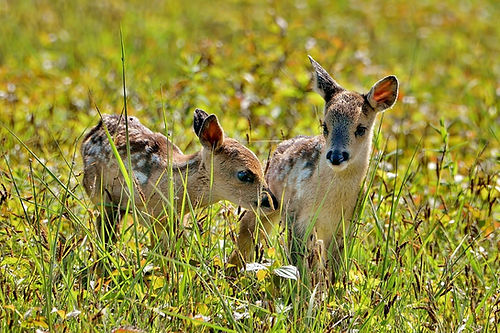%20(2).jpg)
.jpg)
.jpg)
Saturday 14th May West Wood and Stockbridge Down : An unofficial field trip today to West wood and then onto Stockbridge Down, where the weather turned out to be more like summer, than spring. Again looking for the Duke of Burgundy it sort of turned out to be a bit of a triumph at both sites. At West Wood where the area surveyed is of new Oak plantation interspersed with lush growth of Primroses. I have been coming to this site now for about 10 years and today was the best count I've ever had in a woodland outside of Porton Down. We counted (20) individuals several females were seen as well but alas no Pearl-Bordered Fritillaries, which I suggest have probably gone from this site. We decided to make a trip over to Stockbridge Down which is the closest site to West Wood with Dukes, and here again it was a triumph, with a count of (10) at the area at Walbury Hill. I usually only normally 2 or 3 at this site, so I probably just caught them at their peak. Again no Pearl-Bordered Fritillaries so they may well have disappeared from here as well.
Everything is so dry so a storm and drenching tonight would be most welcome....
The crazy thing is just as I left Stockbridge down somebody had spotted a rather large butterfly flying in and around the western part of the car-park and it turns out to be a Large Tortoiseshell I curse my luck sometimes.......


.jpg)
.jpg)
.jpg)
.jpg)
.jpg)
Friday May 13th Butser Hill NNR :Today really turned out to be Friday the thirteenth, the weather on the whole was horrid, with a strong wind very leaden sky and only occasionally did the sun appear and make everything look more like May should be. I was at the bottom of the main slope of Butser for about One and half hours and had notched up just (4) Duke of Burgundies. Today was going to be a good count (so I thought!) as I had reckoned that they were at their peak, but I really had to wait to the wind had dropped, and the sun did appear for about 30-45 minutes, and boom the Duke count shot up and at the end of my rather restricted session I had clocked just (30) individuals. Most will say this is an extremely good tally, but I know for sure the number should exceed three times that on a good day. Ramsdean Down is a bridge too far now, especially behind Grandfathers Bottom, so the counts are a slightly more restricted. Other species seen were Common Blue, Orange Tip, Brimstone, Small Heath, Dingy Skipper, Grizzled Skipper, Speckled Wood, Peacock, Small Copper, Brown Argus, Silver 'Y' Moth, Speckled Yellow, Six Spotted Burnet Moth, Common Carpet and I dont know how many Small Tortoiseshell caterpillars were seen feeding on the many Nettles at the base of the site, if they all hatched out there would be some spectacular numbers, but we all know that will never happen.
.jpg)
.jpg)
.jpg)
Thursday 12th May Old Winchester Hill. This site is vast if you do not know where specific species are then it can be like looking for a needle in a haystack. Luckily the Duke turns up year after year in the same places, albeit with less Cowslips to guide you, let's not beat around the bush here, the fact is the Herdwick sheep have eaten about 99% of the cowslips on the site, and I found about a handful walking around. Today I started very early on site at 0900 as the sun was just starting to warm parts of the down up, and the Duke when found was flying around. However an hour later about 10:30 it had completely clouded over and at times when the sun disappeared it was quite cool. Ten species of butterfly were noted today Duke of Burgundy (7) with just one female, emerged in the last 24 hours, Small Heath, Small Copper,a female was seen laying eggs on Sorrell. Many Common Blues, and Dingy Skippers, and only two Grizzled Skippers in the more scrubbier parts. A Common Carpet was seen but not much else moth wise. Several Muntjac deer were seen very close and Roe Deer in the Dead Ash Woods. Several Red Kite and Buzzards were also seen. I did not visit the Adonis Blue slopes as that's for another day.
.jpg)
.jpg)
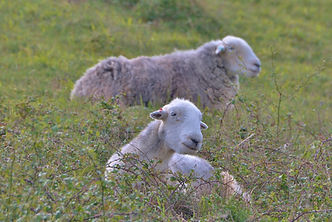.jpg)
Sunday 8th May 2022 Beacon Hill Exton and Stephen's Castle Down Field Trips: Today in very warm and sunny conditions I conducted two field trips and these conditions were very tiring. At Beacon Hill its a bit of a trek to the northern slope to see the Duke of Burgundy we had to maneuver around several cows which conduct grazing for English Nature.We did manage to see one male, but I suspect the Duke of Burgundy is just emerging here. We saw plenty of Dingy Skippers and a few Grizzled Skippers along with the usual fare. The Orange Tip was very common especially along the footpath at the top. Around the area facing south we saw the Common Blue, and Small Blue which is the first time of seeing this species here in 40 years of visiting this site, good numbers of Brown Argus as well. A quartering Red Kite, flew past us so close we could almost touch it. We then had lunch and then went on to Stephen Castle Down, we went in two cars as there is no parking there. We saw up to 5 Duke of Burgundies, all males and a couple of Green Hairstreaks having a battle over Hawthorn with a third joining in. All in all a good day and I would thank all who came which made this a very enjoyable field trip.
.jpg)
.jpg)
.jpg)
.jpg)
Duke of Burgundy aberrations in Hampshire 2022
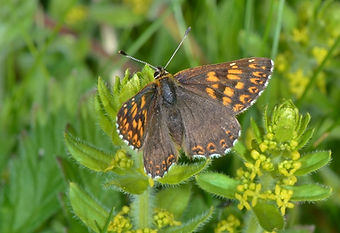.jpg)
male ab.Semibrunnea Osthelder

.jpg)
Male ab.furva
female ab. gracians
Saturday 7th May 2022 Oxenbourne Down : Not a very good day with 75-80% cloud cover with short glimpses of warm sunshine, but despite this my quarry was still around. (8) Duke of Burgundies were observed including a male abb: Furva which is a creamy white colour on top of its wings instead of the orange colour. He was battling with another male for territory, very fiesty little individual. There were also good numbers of Grizzled Skippers and Dingy Skippers, one Small Copper, Small Heaths, Brimstones, Green Hairstreak and several moths one of these was the very red Cinnabar Moth.
.jpg)
.jpg)
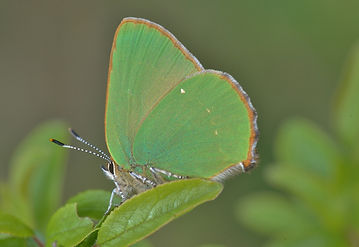.jpg)
.jpg)
.jpg)
.jpg)
6th May 2022 Meon Valley : Visited several sites in the Meon Valley today one successful the other unsuccessful looking for the Duke of Burgundy. At one site I managed to see 24 individuals, including two females and the Ab.semibrunnea, which I haven't seen in a long while. Also seen were Grizzled Skippers, Dingy Skippers, Green Hairstreak, Small Heath, Speckled Wood, Peacock, many Brimstones, Green Veined Whites, but no Orange Tips, Common Carpet Moths, Green Carpet Moth, Yellow Shell Moth, Burnet Companion moth.
Every site visited now has tall dead Ash trees which I've no doubt will be felled in good time, which will actually open up the canopy in some woods letting the flora become more vibrant and some seeds which have laid dormant for years may well get the chance to germinate.
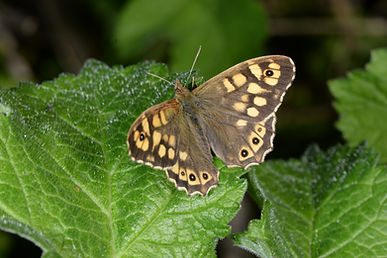


Milton Lock Foreshore 5th May 2022 : I was originally going to a Duke of Burgundy site but the weather couldn't make its mind up whether to be sunny or cloudy so I opted to look around my local patch and really glad I did. There were a few butterflies to be seen Holly Blue, Green-Veined Whites, Small Whites, Small Tortoiseshell, Peacock, Red Admiral, but the stars today were the Reed Warblers, which were chattering away in the reeds occasionally popping their heads up just long enough to get a few shots,and many thanks go to a lovely lady called Sam for pointing me in the right direction. Other highlights were Little Grebes, on the lakes and Curlews and Oystercatchers on the shoreline. The swan's Cygnets haven't hatched out yet.
%20(1024x683).jpg)
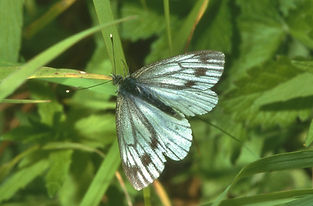
.jpg)
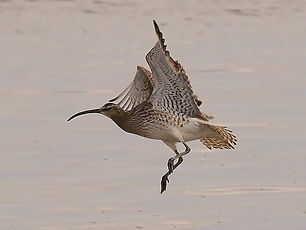.jpg)
.jpg)
.jpg)
Sunday 1st May Butser Hill Field Trip : It took a few brave souls to walk around the lower slopes of Butser Hill today, being overcast and wet, hoping we would come across something that resembled a butterfly, but alas it wasn't to be. We found a couple of 6-spot Burnet moth caterpillars, and a mass of Small Tortoiseshell caterpillars feeding on Nettle. If the cats all hatch out then the slopes of Butser will have a good show of this now much rarer butterfly, but we all know that predation and parasites will have their fill and very few will manage to turn into butterflies. Plenty of Skylarks were braving the elements, and other birds were heard in the hedgerows, like Blackcap and Dunnocks and Robins, the odd Red Kite and Buzzards were quartering the sky above us. Thank You all who came lets hope the weather gets better for the next one!
.jpg)
.jpg)
.jpg)
30th April Oxenbourne Down and Wascoombe Bottom : I have spent the last 2 days at this site, looking at the Duke of Burgundy areas. I spent up to 7 hours over the two days wandering around new nooks and crannies on the down, and I've surprised myself with seeing the Duke in a new area. Over the two days I've counted up to (24) individuals a great count up to the end of April, with just two females at the time of counting. Cowslips are now coming through and the North part of the down is particular splendid. Other species seen were Small Copper (9) Green Hairstreak (7) Dingy Skipper (70) Grizzled Skipper (6) Brimstone (75) Small White (9) Green-Veined White (6) Orange Tip (8) Peacock (8) Small Heath (7) Speckled Wood (2) Holly Blue (3). There were very few moths on the wing Common Carpets, and Mint Moths were mainly seen.
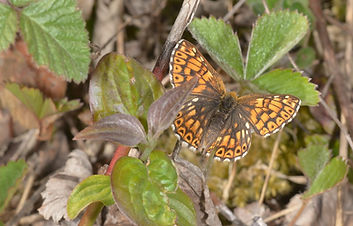.jpg)
.jpg)
.jpg)
Friday 29th April 2022 Oxenbourne Down and Wascoombe Bottom: The wind is still a little brisk on higher ground and still a bit cool but the numbers of different species is building, including the Duke of Burgundy which I saw in double figures today (10) which is unprecedented for this site in April. Good numbers of Dingy Skipper and my first Small Coppers were getting very fiesty. There were several mating pairs of the bloody nosed beetle on the first part of the downs, and the slow-worms are in good numbers underneath the corrugated iron sheets dotted around the site. In all not a bad haul with eleven species of butterfly and one moth a common carpet.
.jpg)
.jpg)
.jpg)
Tuesday 26th April 2022 Finchdean : Went today a site close to Rowlands Castle and area of outstanding natural beauty just inside the boundaries of the South Downs National Park. Here there are plans underway to re-wild several areas which is farmland which has gone fallow. Here there were good areas of wildflowers in natural hedgerows, and good areas of Lady's Smock and other Crucifers and over a period of a few hours up to twenty Orange Tips were seen including several females, and several eggs were located on Crucifers. In the field's they were alive with Brimstones, Small Whites, and Green-Veined Whites. Peacocks were patrolling up and down in the wood, and the hedgerows with the odd Speckled Wood and Holly Blues.

.jpg)
.jpg)
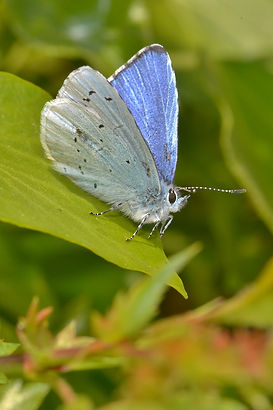.jpg)
Monday 25th April 2022 Butser Hill NNR :The sun may have been shining today, but there was a very keen wind which was keeping temperatures down. Duke of Burgundy numbers (4) are somewhat suppressed because of this, however there were good numbers of Dingy Skipper (35+) Grizzled Skipper (12) Small Heath (6) Peacock (2) Orange Tip (2) Small White (1) Small Tortoiseshell (1) Green Hairstreak (9) Brimstone (6) a few mint moths were noted but nothing much else of note. It's going to be awhile before numbers of Duke of Burgundy emerge, especially if this wind keeps temperatures down as most of the Duke sites are north facing in Hampshire.

.jpg)
.jpg)
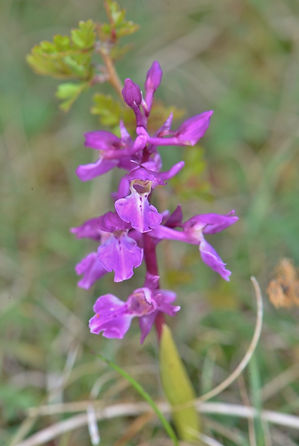.jpg)
Sunday 25th April Matley Heath New Forest Field Trip : A good day to be starting the 2022 field trip programme, looking for the Emperor Moth today in the New Forest and we had two lures to hoodwink the males into thinking there was a female around. It took about 30 odd minutes for us all to get a look at a male came in and investigated, the lures. One male settled on somebody's jeans for quite some time, and I had one stuck on my camera bag, as my lure had been inside the bag for a few days. We saw in all about 5 or 6 males, in several different areas on Matley Heath, although the keen wind probably kept the number down. In the afternoon we tried it out again and sure enough in another part of the Heath we had at least two come and investigate the lures. Butterfly wise it wasn't a great list, but we saw Brimstones, Green-Veined White, Small White, Peacocks, and several Holly Blues. At lunch time we witnessed 3 male Brimstones flying with a female altogether, circulating her and all flying backwards for a time and this was quite a spectacular sight. In the afternoon we went for a birdwatching walk and witnessed Redstarts nesting heard the Cuckoo several times, Mistle Thrushes flying, Jays, Stonechats, also Scalloped Hook Tip Moth, and Common Heath Moth were also seen.
.jpg)
.jpg)
.jpg)
.jpg)
East Meon 21st April 2022 : Visited several sites but no Duke of Burgundies were espied, and really not a lot else despite the weather being really warm. Plenty of Orange Tips, several Green-Veined Whites, Brimstones, Speckled Wood, and Peacock, with a lonesome Grizzled Skipper, to account for my troubles. However the Bluebells look splendid on one hand but on the other hand the amount of dead Ash trees is astounding. Many of the woods in the Meon Valley would disapper if the chainsaws got busy

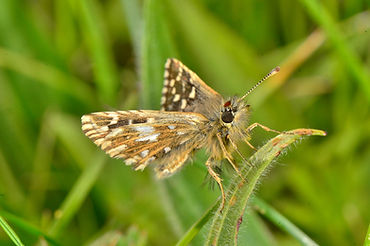
Broxhead Common 20th April 2022: Another Mothing day, and this time I visited the MOD Army ranges at Broxhead Common and here I was looking for the magnificent Emperor Moth, to try out my new lure ready for the New Forest on Sunday. It took sometime to get going but after about an hour or so there were up to (5) Emperor Moths flying very fast and with a mission around the lure. Moving around the site and re-locating the lure and the total was probably about (10) in total all males of course. One male stayed on the heather and was very photogenic and they all seemed to be in excellent condition, although the Gorse will unfortunately rip their wings, and they will soon look quite bedraggled. Other species on the wing were Green Hairstreak, Peacock, Small White, Brimstone, and many Orange Tips on the roadside verges going up to the site.
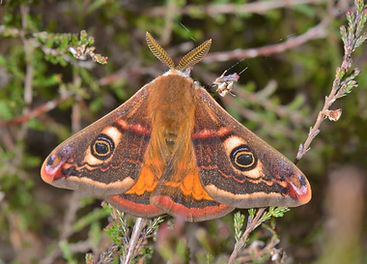.jpg)
.jpg)
Moth Trap 19th April 2022 : It's not everybody's cup of tea, and it takes a good morning of patience but moth trapping is progressing into my bloodstream and I've been hooked now for several years, after buying a inexpensive moth trap about 10 years ago. I'm fortunate enough to put it out into a wood where I can reap the full benefit of what moths may be passing and last night was no exception. With (13) species on my list with Nut Tree Tussock, Bridled Beauties, Oak Beauties, Hebrew Characters, Lunar Marbled Browns, Frosted Greens, Scalloped Hook Tips, Engrailed, Great Prominents, Pebbled Prominents, and Common Quaker. A good haul for such cold nights. On the Island the Dingy Skipper, Small Copper and Green Hairstreak are emerging in numbers, as well as on the mainland, at Butser there has been good counts of Grizzled Skipper and Green Hairstreak.
.jpg)
.jpg)
.jpg)
.jpg)
.jpg)
.jpg)
Oxenbourne Down 17th April 2022: Another glorious day with a bit of a breeze which may have kept some of the species showing themselves more, however the first Grizzled Skippers were out (3) seen, also seen were Orange Tip (2) Green-Veined White (2) Peacock (8) Comma (3) Brimstone (20+) Small White (2) there has been a fair bit of scrub bashing done on top of the down, however the area of Gorse has been left untouched. In Wascoombe Bottom there is a lot of sallow showing itself now, hopefully this could attract a wandering female Purple Emperor, this would certainly enhance the flora and flora of the site as they are certainly over the road in Queen Elizabeth Country Park. Beware of Ticks, they are rife this year. I mainly put it down to the amount of deer in the area now as I saw at least 8 Roe Deer hinds, there were a couple of Slow worms at rest underneath some shelters but unfortunately no Adders. In other circles there was some good sightings of Spoonbills flying over Titchfield Haven the other day and at Oxenbourne Down today there were good sightings of Skylarks and male and female Buzzards quartering the sky.
.jpg)

.jpg)
.jpg)
.jpg)
Noar Hill 16th April 2022 : My first visit to this site in 2022, and what a day excellent weather, and 10 species of butterflies. (2) Duke of Burgundies seen both males both probably emerged today or yesterday, all the cowslips look in good condition, and the site has had a lot of management, with some chalky scraps carved into the some of the pits, I assume this is to encourage Cowslip growth. Other butterflies seen on the wing were Small Tortoiseshell a female was seen laying eggs. Peacock (8) Comma (3) also a female was seen laying on Nettle in the hedgerows at the entrance.Brimstone (4) Large White was seen at home, Small White (5), Green-Veined White, male Orange Tip, and (5) Holly Blues.
.jpg)
.jpg)
.jpg)
13 April 2022 Portchester Common and Anson Grove A look around a old favoured site in the past where I used to see 'heaps' of Wall Brown!, however today it was perfect sunny weather at times, with Holly Blue (2), Small Tortoiseshell(1) Peacock (15) Brimstone(6) Small White (7) Red Admiral (1)and Comma (1). No Orange Tip despite being in favoured areas where I've seen them before nectaring and laying eggs. Portchester Common is not what it once was, and Anson Grove is a local site owned by Fareham Borough Council, with lots of flowers and grasses, and trees, right next to a housing estate.
Mark Tutton today saw the Grizzled Skipper at Butser Hill, and the Green Hairstreak has been seen in Sussex.
.jpg)
.jpg)
.jpg)
.jpg)

.jpg)
.jpg)
10 April 2022 Portsdown Hill: Another day of cool winds and a walk around the western end Fort Widley, and there was very little of note butterfly wise, just one Peacock managing to stay out of the cool wind. However there was lots of bird-song, with BlackCaps, Hedge Sparrows, and Robins giving it a good sing-a-long. With the constant chatter of Skylarks above, which is where I noted two Peregrine Falcons on the wing, whether it was a pair or not I'm not sure, however one was observed flying down catching prey, and Red Kites, Buzzards, and Kestrels were also on the hunt. I had a look at the Falklands memorial woodland which has a tree planted for every one who died in the conflict, and as you can see from the photo after 40 years the trees are quite established.On the way down from the car-park by the hospital, I managed to see at least 5-6 Brimstones on the wing, these were well out of the wind, and facing south meant it was obviously a lot warmer there.
.jpg)
.jpg)
.jpg)
09 April 2022 East Meon and Milton Allotments : Another disappointing day, despite good sunny weather to start with, at East Meon on high ground it was particularly cool, and consequently very little in the way of Butterflies seen. In the sheltered wildflower banks there were great swathes of Cuckoo flowers and Sweet and Dog Violets along with other wildflowers, all looking very splendid, however I only saw several Peacocks and a Small White for my efforts. However counting up to half a dozen Hares was a triumph and some young rabbits. At Milton Allotments when I got home there were certainly much more on the wing, with up to (5) Small Tortoiseshells several doing battle with a Comma joining the fray. Several Peacocks were also seen along with at least a dozen or more Small Whites. Another sign of spring the Cuckoo was heard in the New Forest yesterday, let's hope it does better than it did in 2021!
.jpg)
.jpg)

Spring is in the air as every passing day it hopefully gets warmer and more species of butterflies and moths become noted on the wing in Hampshire and the Isle of Wight. In the past few days more Holly Blues have been noted, and the Orange Tip is also becoming more frequent on the wing. Clouded Yellows 'home grown ones' have been noted on the Island. In the air there have been good views of the White-tailed Sea Eagle over Titchfield Haven a thank you to Steve Simnett for letting me use his magnificent shot of one as it flew over his head, and Dartford Warblers are becoming more common on the heathlands of the New Forest and other areas. Brown Hairstreak caterpillars are now starting to emerge and starting to feed up on Blackthorn leaves. Green-Veined Whites have also been noted on the Island and in Gosport.



03 April 2022 Milton Lock NNR : Despite very warm weather today at my local patch I only saw my first two Speckled Woods and two Small whites for my trouble. At home I came across a Cabbage Moth caterpillar, and a Pupae in a flower pot of the same species. News from the Isle of Wight Andy Butler has seen a Elephant Hawk Moth. Over Titchfield Haven there was a great sighting of a magnificent White Tailed Sea Eagle.
.jpg)
.jpg)
.jpg)
.jpg)

.jpg)
April 2nd 2022 The Moors : This is a new site for me I've always had a quick look /glance driving past on the way to Bishops Waltham, a little wet oasis in the middle of a large housing estate. Yesterday I managed to get a look at the site, and I quite impressed with the wet areas, and the wooded areas. However there was very little wildlife seen as it was quite cool in a keen wind.

Large Tortoiseshell seen on the Isle of Wight
Large tortoiseshell taken by Mike Hurst on the 21st March 2022 at Parkhurst Forest on the Isle of Wight, one of many seen(?) some were squabbling with the peacock butterflies... to the north of the forest along a footpath were half a dozen Commas. Back into the forest and we saw just one bright yellow Brimstone...
If your out and about where there are a fair few Wych Elms in an area where this species has been reported then now is the time to look for this species they normally mate in early April, and the female will lay good batches of eggs on the terminal twigs of the Wych Elm sometimes along tall hedges and or suckering scrub. Usually 3m or 10 feet up or sometimes in the crown of a tree, where binoculars are a must. Sallows and Willows are sometimes used, and occasionally Poplars, Aspen Birches, Wild Cherry and Pear. (Ashley Whitlock)

A row of healthy Wych Elms
25th March 2022 Park Hill : A visit to one of the most picturesque areas in the Meon Valley Park Hill, probably a site very few people visit. Its always been a site that I have always thought the Duke of Burgundy may well inhabit one day. Today in bright sunshine along one of the country lanes where several large Beech trees had been felled during the storm I suspect, and consequently the sunshine was now falling on the hedges and flowery side of the lane and here there were several Brimstones, Small Tortoiseshells and Peacocks, all feeding on Hawkbit and Ivy flowers.On the downland there was an area where the new growth of Nettles was just coming through and I saw at least (4) Small Tortoiseshells, all very downbeated and faded, these looked like females looking for a spot to lay eggs. One Comma was also espied looking for a suitable site to lay as well. In the church graveyard there were more Brimstones, Peacocks and Small Whites. A good count today of all of the hibernators. Along with Red Kites many Buzzards spiralling upwards on the thermals, a hunting Sparrowhawk and the constant barking of crows in the many rookeries around the site.

.jpg)
24th March 2022 Fort Cumberland : A quick visit to see what invertebrates could be seen , there was very little in the warm sunshine. The odd Brimstone, Small Tortoiseshell, Small White and Peacock. The Stonechats were busy looking for nest sites, but I didn't see a Dartford Warbler.

.jpg)


Clouded Yellow reported by Andy Butler along the revetment at Wheeler's Bay with a single on 21st and two on 22nd. They are almost certainly locally bred rather than immigrant arrivals. Also look out for Orange Tips males have been seen in Gloucestershire and West Sussex its only a matter of time before they will be seen in Hampshire.

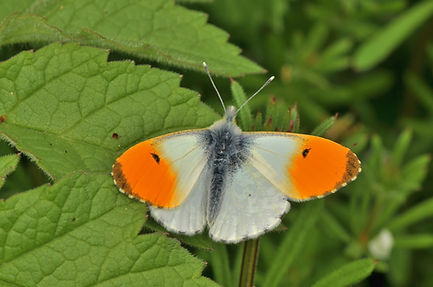
Wednesday 23rd March 2022 Milton Lock Nature Reserve, and Winchester Cathedral: Another visit to my local reserve which is now becoming a magnet for some good butterfly counts. Today there were several Commas on the wing one of these was in combat with a Peacock on his territory. I counted at least (5) Peacocks flying around enjoying the sunshine and a Red Admiral and a Small White were also seen. Away from Portsmouth it's all happening at Winchester Cathedral as Winnie and William settle down to breed. The first egg Winnie layed was eaten by her as it would seem it cracked. Winnie has subsequently layed another two eggs, and here's hoping these will be more successful.
.jpg)
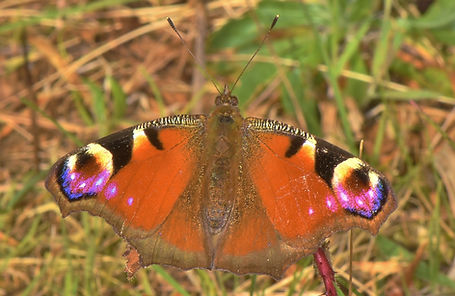


17th March 2022 Milton Southsea : Yesterday in my garden in Southsea there was a flurry of butterflies including Brimstone, Small Whites, Peacock, Red Admiral, and Comma. This is the best count I've ever had in the garden in March. Lets hope its a good omen for 2022, boy do we need it!
Tuesday 15th March 2022 Portsdown Hill and Milton Lock reserve : It was promised to be a warmish day but the sun decided to hide behind a veil of cloud which hindered sightings, however I did see on Portsdown Hill up to (4) Brimstones and a Peacock butterfly, which was imbibing on some Gorse. Had it been sunnier I feel I could have seen another two or three species. The Kestrels were hunting and the Buzzards were soaring on the thermals rising up from the chalk-pit. The Flora on Portsdown Hill at the moment is dominated by good clumps of Common-Dog and Hairy Violets which helps the Dark Green Fritillary breed here. There wasn't much at Milton Lock reserve again lack of strong sunshine, but there were a lot of female Bumble bees flying around and were also resting on warm bundles of grass which had been cut.
.jpg)
%20(621x760).jpg)
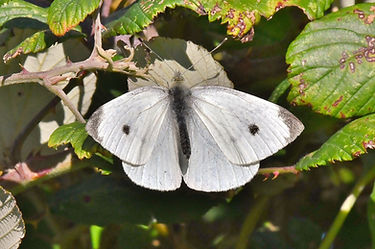
.jpg)


.jpg)
.jpg)
Saturday March 12th 2022 Milton Allotments: Again another day of fine sunny weather rather spoilt by the cold wind which persists everytime the sun comes out for any great length of time. I did however see my first butterfly on the wing a Small Tortoiseshell, which was happy sunbathing in the cool sunshine. I did see another butterfly fly down inside the Allotments but I could not ID it, however I would guess another Small Tortoiseshell or Peacock. The Foxes seem to love basking in the sunshine but they are quite hard to see, keeping out of the way of dog-walkers. In the estuary the tide was out and the Brent Geese were busy feeding up, I suspect they will be going home very soon. On facebook the page known as 'Keep Milton Green' somebody has reported seeing a Muntjac deer walking down her road...? There has been sporadic reports of these little timid deer being seen in the Fort Cumberland reserve, however I've never seen one, with so many dogs being walked there I suspect people have mis-Identified them. I would love to be proved wrong, but these deer like the cover of woodland, and there is very little cover in the heart of Portsmouth like this.
David Stephenson has reported a nice group of Adders on Browndown ranges on Gosport including a Blackadder, no jokes about Rowan Atkinson !(shown in the photo)
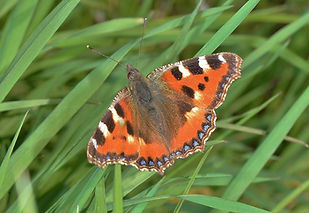.jpg)
.jpg)
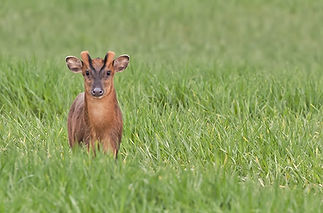

Photographs of the Black Adder by
David Stevenson

Wednesday 9th March 2022 Winchester : Fabulous day spent at Winchester today the reason I went was to photograph the Peregrine Falcons Winnie and William who have mated and are hoping for patter of tiny talons on Winchester Cathedral. I saw Winnie sat on the Cathedral but she wasn't doing much, I think she was waiting for her mate to return and feed her. There was an audience at one point as I joined another photographer who was a seasoned Peregrine photographer, amongst other birds as well. We certainly drew a crowd as most people passing by didnt have a clue about there most famous birds, as we told them what was going on, about the cameras, how the birds feed, how long Winnies been present at the site, and how many chicks she has reared. I also saw some very tame Redwings, which are preparing to migrate back to Scandinavia. A very unusual setting for them in the Cathedral grounds, but they were hunting worms, which they found on several occasions.
.jpg)
.jpg)
.jpg)
.jpg)
Seen in Fleetlands Gosport a lovely Oak Beauty Moth taken by Andy Knight on the 4th March 2022, mainly a woodland Moth flying between February and May, so if you have a few Oak trees dotted about these are well looking out for, and they do come to Moth traps. Other butterflies and moths being seen are Red Admirals, Comma, Peacocks, Early Thorn Moth, Common Quaker, March Moth, Dotted Borders around Hampshire and the Isle of Wight.. I also noted in my garden Queen Wasps nectaring, which I dont see that often, but they are quite intimidating to look at almost the size of a Hornet. It is still very deceptively cold so the grand opening of the butterfly season I suggest is on hold at the moment.

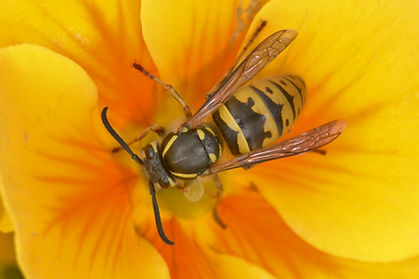.jpg)
Sunday 27th February 2022 Portsdown Hill A very bright day but Portsdown Hill was decidedly deceptive, with a very cool northerly wind blowing, which put paid to any butterflies I feel, even the birds were in short supply with just Kestrels on the hunt, and Buzzards being mobbed by crows with the normal birds in the hedgerows. It was all was very disappointing, with no real shelter to speak of. When I got home at Milton in the evening sunshine I saw a Fox sunning itself. All in all February has been a very cold and windy month.

%20(1024x779).jpg)
Milton Lock Nature reserve Saturday 26th February. Another warmish day with cool winds keeping much of what I was looking for suppressed. Certainly no butterflies about, but the insects were busy getting nectar, and flowers and trees and shrubs were all coming out in bloom, which is a great sight to see, knowing spring is just around the corner.....................
.jpg)
.jpg)
.jpg)
High pressure over the southern part of England now is bringing out a flurry of sightings of butterflies. Yesterday I saw my first one, a Peacock caught up in a spiders web in the windows of the Church of the Resurrection at Drayton, fortunately it was rescued and put outside and seemed very grateful. Other sightings are very early Speckled Woods in Hampshire.

.jpg)
Butterflies are waking up from hibernation......Several reports around Hampshire have had sightings of several Red Admirals, Peacocks, and Commas with a sprinkling of Brimstone and Small Tortoiseshell. Look out for these in calmer conditions obviously on a warm day , in a sheltered position. Also White-Letter Hairstreak eggs have been found on Wych Elms , but I'm waiting for the first report of the Large Tortoiseshell, which was seen around this time last year...here's hoping!

%20(1024x699).jpg)
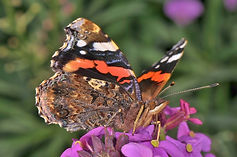

Saturday 19th February 2022 Portsmouth A look at some of the areas which were most affected by the storm on friday and to a lesser degree on Saturday as well, obviously being a seaside town the main area of contention was the waves coming ashore, and along the main sea front the areas of large parkland in and around Old Portsmouth were well flooded, and here the sea birds like Black headed and Herring Gulls took advantage of the calmer conditions, looking though rather odd all sat together in the middle of a muddy field. There were great concentrations of Starlings digging up grubs and worms which had come to the surface where it was awash with sea water. I feel that Portsmouth may well have a murmuration of Brighton size in the near future judging by the amount of Starlings there were! In the parks and gardens the trees seemed to have escaped any major damage, and I didn't see any trees fallen, although I suspect there were a few. The Robins near to the Rose gardens were in good singing voice and it was good to know they were OK along with all the birds on the Canoe lake especially the Swans, which have swollen in their ranks over the past few years. Away from Portsmouth looking at the camera footage of our 'Winnie' the Peregrine on Winchester Cathedral she seems have got through the storms OK as it must be quite scary up on those buttresses in those strong winds. The camera footage shows her in good condition, and she has mated with a male so we are expecting the sound of tiny feet in the near future!
.jpg)


.jpg)
.jpg)
2022 Early News on the Purple Emperor by Matthew Oates
2022 could be an annus mirabilis for the Purple Emperor, though much needs to go right and an awful lot mustn't go wrong...
Last year saw a surprisingly good egg lay and a goodly number of larvae entered hibernation. That's a big plus.
To date, winter losses have been low at some monitored sites (only 25% have been predated to date in my local woods, and 33% at another monitored site east of Swindon), though Ben Greenaway has recorded 60% losses so far (mid-Feb) in West Sussex and I've recorded similar losses in the Great Tit haven that is Savernake Forest, my main study site. The mid-February to early March period sees the highest mortality during hibernation.
Another period of high loss seems to be the pupal period, though we are only just starting to study this in the wild. It seems that the longer this butterfly spends in the pupal stage the fewer Emperors we see on the wing.
This year we have The Queen's Platinum Jubilee in early June, when many larvae should be pupating. Please note that the track record of the Great British Weather during Royal Jubilees is nothing short of appalling - c/f the heavy cold rains of June 2012 and 1977. Even Queen Victoria's Diamond Jubilee in 1887 was ruined by the weather - an extreme heatwave ended in an apocalyptic heatwave which caused considerable crop damage...
Watch this space. Whatever will be will be, but it will be interesting...


Milton Lock and Foreshore 12th February 2022 A walk where the tide was out so far it was just a green carpet of seaweed and algae, with many seagulls and Brent Geese and the odd Oystercatcher feeding in the distance. In a tree close to the allotment were Greenfinches and the odd Goldfinch to be seen. I haven't seen Greenfinches now for many years. On the reserve on the wooden posts was a Kestrel, just content in sitting there, looking at the grass which had been cut, by the volunteers who look after the site, and he never saw me looking at him or was it a she? Somebody had walked past it just a few minutes before I got there and had no idea it was there , just shows you some people have no idea what is going on around them....?

.jpg)
.jpg)
.jpg)
Friday Meon Valley Meonstoke 11 February 2022 A Visit to one of favourite places yesterday with many wild flowers now starting to open and many trees are in bud. Birds were starting to gather nest material and Buzzards were doing there courtship displays in the skies above. Herons and Egrets were fishing in the River Meon and the local's were laughing in a truly magical place where time is asleep.

.jpg)
.jpg)
.jpg)
For the sixth year running, Winnie the Peregrine has returned to the high ledge of Winchester Cathedral.
The resident falcon, who had at least 25 chicks at the breeding site with her late mate Chester, has been spotted over the past week on the Cathedral Peregrine-Cam, with further sightings of her flying around the cathedral.
Winnie, who hatched another three Peregrine chicks in 2021, will now sit in wait of a new potential mate after Chester died in May last year.
Providing an update on Winnie's return, one of the Virgers at Winchester Cathedral, Ian James, said: “There is a little bit of an update on the Peregrines, we have now seen the female around the cathedral, and it has actually been seen up on the ledge within the last week.
“At the same time, we are now up and running with our Peregrine page on the website and the cameras are live. So, if you look on that from time to time throughout the day, there’s a very good chance you’ll see the female at the nest site.”


Photo: Nikki Kinowski
Isle of Wight sea eagles: Police investigate after two found dead
The birds, which have a wingspan of up to 2.5m (8ft), had not been recorded in England since 1780
Two young sea eagles, from a group reintroduced on the Isle of Wight, have been found dead.
Police said one white-tailed eagle was found in Dorset in late January along with a second in the south of England.
Post-mortem and toxicological examinations are being carried out on both birds to find out how they died.
The force has appealed to anyone with information about the deaths to come forward.
The birds are all fitted with GPS tracking devices, allowing their flight paths to be monitored. Three other eagles from the group on the island are known to be in Dorset.
The birds are part of an ongoing conservation project, run by Forestry England and the Roy Dennis Wildlife Foundation.
One of the young sea eagles was found dead in Dorset in late January, police said
The project started in 2019 and sees at least six birds released annually on the Isle of Wight.
Data from the trackers has shown they explore widely, making flights of more than 100 miles (160km).
In England, they have flown as far as Norfolk and North Yorkshire, some have made journeys as far as France, the Netherlands, Germany and Denmark.
Many of them return to the island after their travels.
The Isle of Wight was chosen to reintroduce the coastal loving white-tailed eagles, also known as sea eagles, as it offers an ideal habitat with plenty of fish in its surrounding waters.
They are the UK's largest bird of prey, with a wingspan of up to 8ft (2.5m) and feed mainly on fish and water birds.
Wednesday 02 February 2022 Milton Lock foreshore Another walk along my local foreshore in glorious sunshine, to see the first signs of an 'early' spring with Crocuses out and Bumble Bees making hay whilst the sun shines. There were good flocks of Brent Geese who will be going home next month...doesn't seem like five minutes since they arrived! There was plenty of chattering the hedgerows with Starlings, Sparrows, Goldfinches all in good numbers. Still no butterflies have been seen, my local patch Milton Lock Nature Reserve has all been cut as the Covid problem stopped any sort of management there.
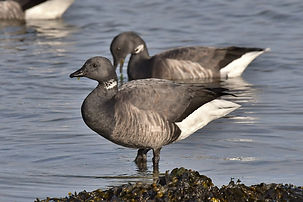.jpg)
.jpg)
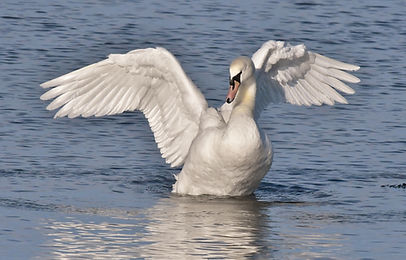.jpg)
.jpg)
Andy Butler has reported a Holly Blue at Wheeler's Bay on the Isle of Wight just after lunchtime. This is the second January sighting of this species for the island with Andy also reporting one from the same location on 17th January 2011. Meanwhile here are some Holly Blues from the summer of 2021 that I took in my garden.
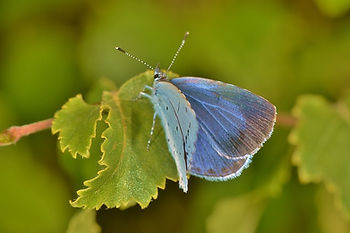%20(1024x683).jpg)
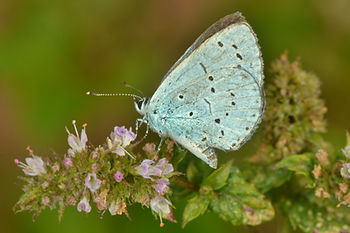
Monday 31st January 2022 Langstone Harbour A bitterly cold day out and about especially by the seashore, where I always seem to be at the moment looking at all the shore birds that gather and feed in and around Portsmouth and close-by at Langstone Harbour just off of Hayling Island. Today the weather was overcast and windy most of the time but the sun did shine albeit briefly in spells, I spied a large group of Black-tailed Godwits, must have been 50-100 of them all flying together, and these landed not far from me, feeding in and amongst the Brent Geese who seem to be everywhere I go. Other birds seen were Redshank the odd Curlew, Knots, Lapwings, Rock Pipets, Shelduck, Cormorants, and Gulls. Also observed and photographed was a Rook finding a Cockle on the seashore, and flying up in the air with it and then dropped it from a modest height and then it flew down to feed on the content. (this was observed on last weeks Winterwatch programme)
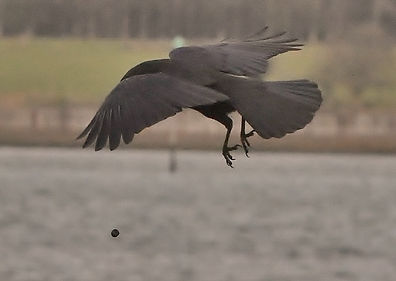.jpg)
.jpg)
.jpg)
Farlington Marshes Thursday 20th January 2022. Another chance to see the Bearded Tits in action, but the cold weather, kept their heads down I think, I did see one but it was just the one and too far away for any pictures. There were good views of Avocets, Pintails, Teal, Redshank, Curlew, Brent Geese, Stonechat, White Egrets, and foxes were hunting on the grassy areas. Plenty of birdwatchers about all looking for the same thing!

.jpg)
.jpg)
.jpg)
Tuesday 18th January 2022 Milton Foreshore. Up at the crack of dawn yesterday to see the final fling of the 'Wolf Moon' in all its glory. It was well worth the effort as the wildlife were up before the sunrise, with Foxes hiding in the shadows, and beating at hasty retreat when I got too close to them. The Brent Geese at this time in the morning are very vocal, and also the Curlews and Oystercatchers are making lots of noise as well. I saw several Kestrels sitting in the trees just awaiting the sunrise and to start hunting. All the vegetation was white from a hard frost, and Ice had formed in any puddles on the footpaths. However the two main lakes were free from Ice and the birds were very active for this time of the morning.
.jpg)


.jpg)
Monday 17th January 2022 Milton Shoreline A walk along the Milton Shoreline and there were several species of waders and Geese feeding and taking in the sunshine to be seen. There were Redshank and several of these were standing on one leg, and seemed to be hopping along when they moved, although in flight I could easily see 'both of their legs'. In the trees there were several lovely Long-Tailed Tits, all chattering amongst themselves which really gives them away.
Monday 17th January 2022 Home I had a Double striped-pug moth resting on my car today and it managed to stay there throughout a journey of several miles until we got back home where I photographed it. Usually seen in April-May and August but another mild winter has brought it out early. No early butterflies as yet, despite the warmish weather!
.jpg)
Friday 14 January 2022 Portsdown Hill Perfect weather for walking around one of your favourite wildlife sites, Portsdown Hill was glorious today, and the wildlife didn't disappoint, although it was mainly birds, I did look for butterflies especially the Brimstone which I though may well have woken up in this weather, however it wasn't to be. Birds seen on the Hill were Red Kite, Buzzards, Stonechat, Kestrels on the hunt, Long Tailed Tits, Blue Tits, Great Tits, Robins, Blackbirds, SkyLarks, and Rooks just to name a few. There was plenty of berries to be seen, but very little in the way of wildflowers..yet. The Gorse was in bloom and Honey Bees were necturing.
.jpg)
.jpg)
.jpg)
Its all kicking off in Hampshire at the moment with many observers putting up sightings on the Hampshire Birding pages and the Isle of Wight. Here the Primroses are starting to bloom and with this warm sunny spell this will bring about many spring flowers, far too early. Mind you the frosts at night are very cold. But this hasn't stopped the first butterflies, Peacocks and Red Admirals being seen over the last few days. Yesterday I saw many Roe Deer in a wood close to Finchdean and some glimpses of Hares in the fields dotted about.

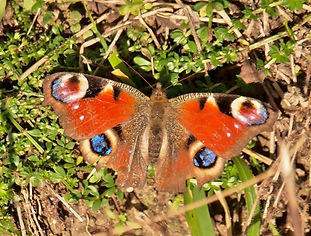

Photo of Primrose and Peacock butterfly by Kay Shaw Isle of Wight
Sunday 9th January 2022 Milton Foreshore Another rare day away from the driving rain, again just local, with hundreds of other people out and about dog-walking, and bird watching as well. Good views of the Langstone Estuary with the tide out, with hundreds of Brent Geese, and Knots feeding also Oystercatchers, Curlews, and Redshanks. Also seen were Kestrels, hovering and dont forget the more commoner species are actively getting ready to nest now, Blackbirds, and Robins were singing with plenty of Sparrows in the Brambles. I didn't see any butterflies, although I expect they were about as it was very mild indeed. On the Lakes there were Mute Swans, Mallards, Coot and Moorhen, with Black -Headed Gulls frantically trying to get some of my bird feed. I noticed that catkins were starting to flower, and many bulbs were germinating, Daffodils and most of the trees were budding up. Everything is far too advanced.
Painted Lady reported on the Isle of Wight. RSPB Assistant Warden Luke Gaskin reported and photographed a Painted Lady on ivy in Centurions Copse at Brading Marshes RSPB reserve on Wednesday (5/1/22).
This is believed to be the third January record for the Island for this species with previous reports on 6 January 2016 and 1 January 2013, both at Wheeler's Bay. [Posted by Jim Baldwin] There has also been several Red Admirals reported as well dotted about the county. To think 25 - 30 odd years ago these reports would have raised a lot of eyebrows but because of Global warming now these butterflies seem to have adapted to our 'warmer' winters.
.jpg)
.jpg)
Wednesday 5th January 2022 Southsea Castle. Happy New Year to all my readers, let's hope 2022 is better than 2021, and here's hoping to to report on lots of wildlife in and around Hampshire. If you have seen the new field trips programme for 2022 then you will have seen its quite a full on programme with at least 4 walks in every month from May until the end of August. If you haven't had the pleasure, then have a go and visit me and some of my lovely friends on a walk I guarantee you won't be disappointed. Today another nice day and my first venture out in 2022 and I visited Southsea Castle where on the shore-line are several Purple Sandpipers to be seen wading onlong the concrete fortifications, trying to avoid being drowned when the sea engulfed them every so often. Also there was a couple of Rock Pipits, which look very similar to a Thrush, but these were not as easy to see especially looking into the sun.
.jpg)
.jpg)